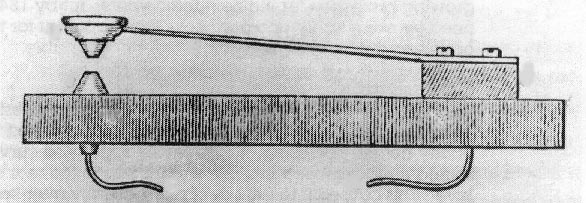
50a THE VAIL 'CORRESPONDENT':(41KB) This simple so- called 'strap key' was used in early tests by Morse and Vail that led up to the 1844 demonstration. It was given the name 'strap key' because it consisted of just a simple strap of spring brass.
(The instruments are in approximate chronological order: Oldest first.)
* = (Items no longer owned.) ** = (Items in other collections.)
PART I
50 THE ORIGINAL MORSE TELEGRAPH KEY was actually a notched piece of metal
called a Portrule. It was pulled along and the parts of the metal that were
not notched made contact with another piece of metal, completed the electrical
circuit, and produced the dots and dashes of the Morse Code.

50a THE VAIL 'CORRESPONDENT':(41KB) This simple so-
called 'strap key' was used in early tests by Morse and Vail that led up to
the 1844 demonstration. It was given the name 'strap key' because it
consisted of just a simple strap of spring brass.
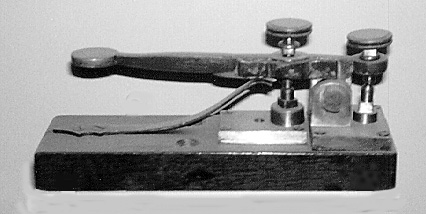
50b THE ORIGINAL MORSE TELEGRAPH KEY CALLED THE 'LEVER
CORRESPONDENT' THAT WAS USED IN THE 1844 BALTIMORE-WASHINGTON
DEMONSTRATION:(36KB) This key is on display in the Smithsonian Institution
in Washington, DC and it is on loan from the Vail Museum in Morristown,
NJ.
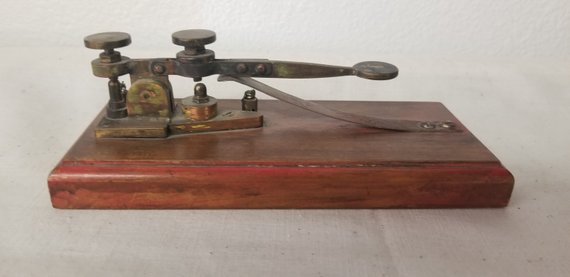
50h A VERY NICELY MADE REPRODUCTION OF
THE VAIL LEVER CORRESPONDENT This key has the same design features
as the original key. It has a very old-looking patina and it takes a few
minutes to be certain that it is a replica. It is about 30% smaller than the
original and looks very much like it. However, the hex nuts on the adjusting
screws and on the lower contact posts are totally different from the square
nuts used in the original. This key was purchased by Jon, WS1K. It came from
an estate in New Mexico but no further information is available.
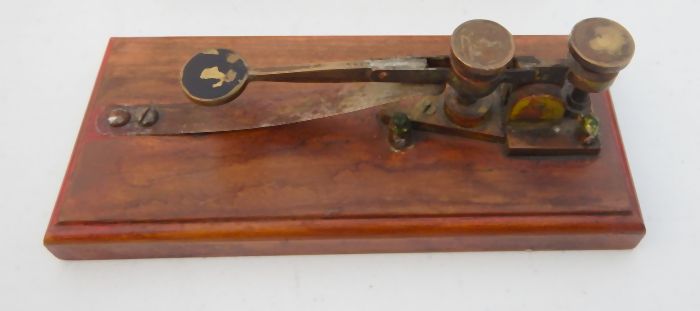
50i A RIGHT side view of the reproduction
Lever Correspondent made by an unknown maker.
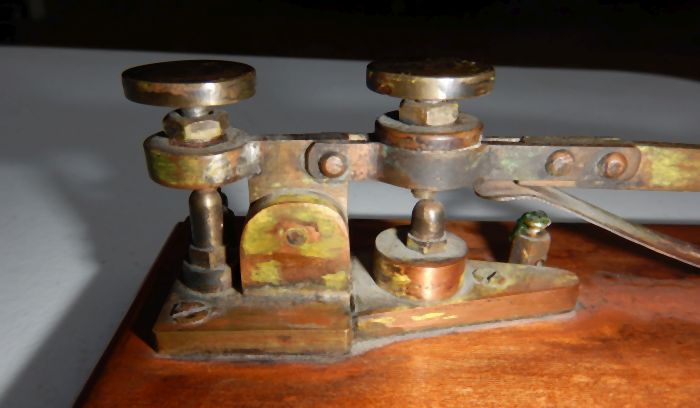
50i A closer view of the right side of
the reproduction Lever Correspondent made by an unknown maker.
Notice the hex nuts on the adjusting knobs and the lower contacts. No hex
nuts were used in the original.
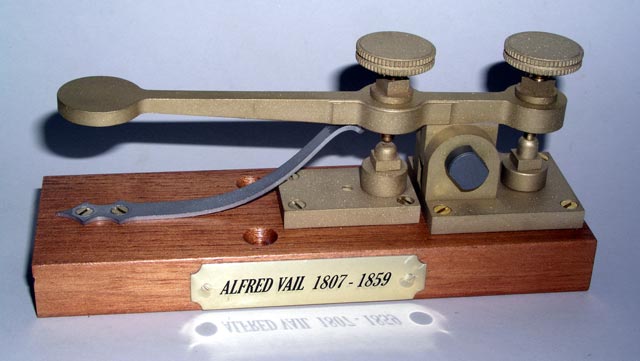
50x A REPRODUCTION OF THE VAIL LEVER
CORRESPONDENT MADE BY KENT IN ENGLAND:(38KB) This key has the same general
design and measurements as the original key but various production versions of
the Kent key have been given sand-blasted and other finishes which make it
look quite different from the polished brass of the original. Many owners have
tried to achieve the weathered and aged patina of the original key in the
Smithsonian Institution. Several techniques for developing an aged patina on
the key have been tried. One that works quite well is to bury it in the ground
for about a year and then gently clean off the dirt.
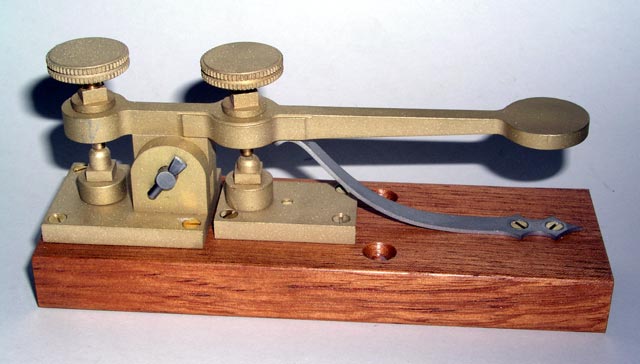
50y A LEFT side view of the Lever Correspondent
Reproduction by Kent:(42KB)
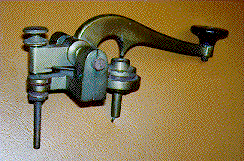
50z ** THE EARLIEST CAMELBACK KEY THAT I HAVE
EVER SEEN:(50KB) Owner anonymous.

51 ** EXTREMELY EARLY PALMER AND HALL BOXED COMBINATION
TELEGRAPH KEY AND RELAY SET:
This extremley rare Palmer and Hall telegraph set is contained in a wooden box
that protects the early camelback key and relay from damage. One end of the
box folds down to allow operation of the set while still in the box. The
relay and the box are labeled: Palmer and Hall and the box label reads: PALMER
& HALL electricians, 158 Washington St. Boston, Mass. The box measures: 8.5 x
6 inches. The owner was kind enough to allow me to include these photographs
in my museum prior to selling it on ebay.
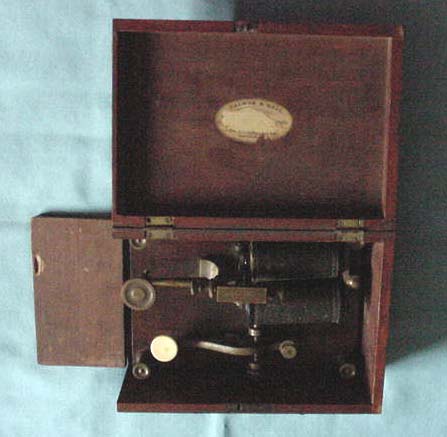
51a ** The Palmer & Hall Telegraph Set in its Original
wooden box.
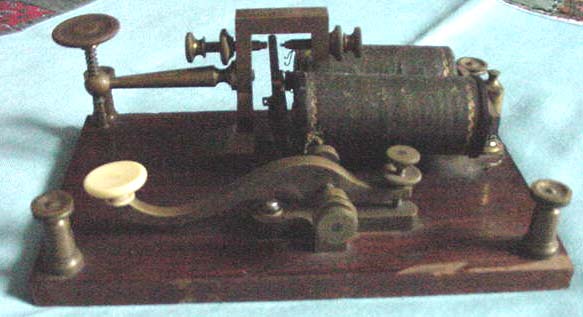
51b ** A different view of the Palmer & Hall Telegraph Set
showing the telegraph key more clearly.
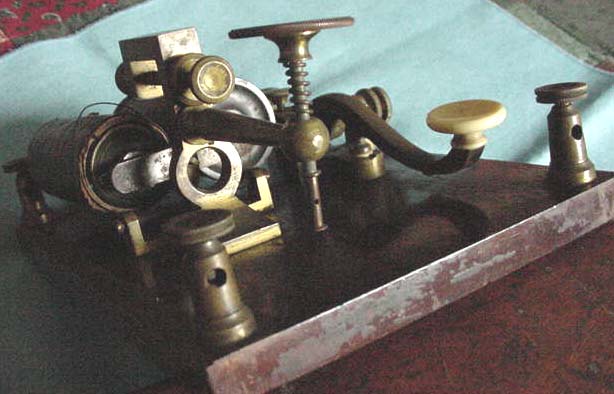
51c ** The operator's end of the Palmer & Hall
Telegraph Set.
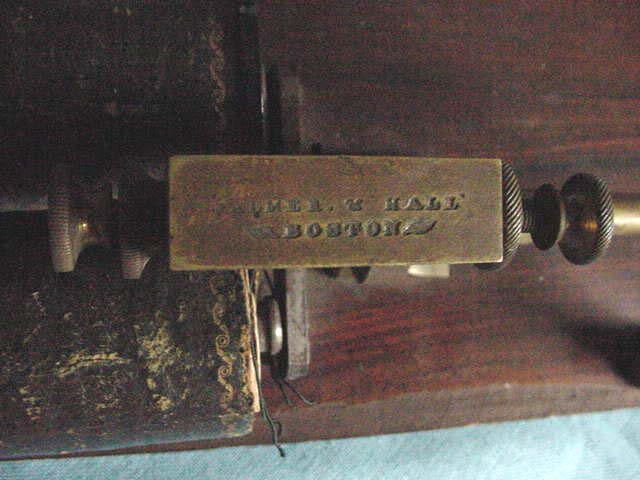
51d ** The Maker's Mark on top of the relay in
the Palmer & Hall Telegraph Set.
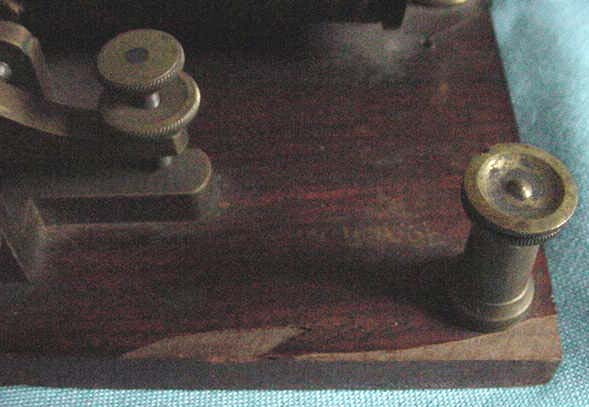
51e ** A close view of the far end of the key and a
terminal in the Palmer & Hall Telegraph Set.
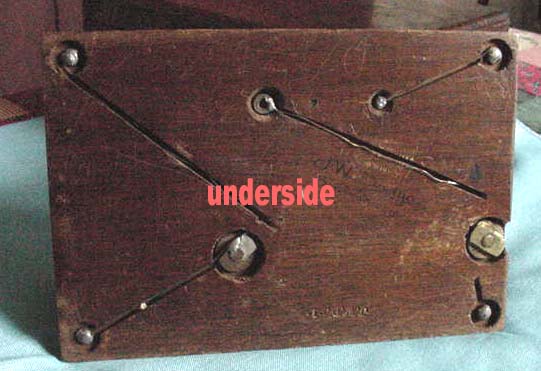
51f ** The underside of the base of the Palmer & Hall
Telegraph Set.
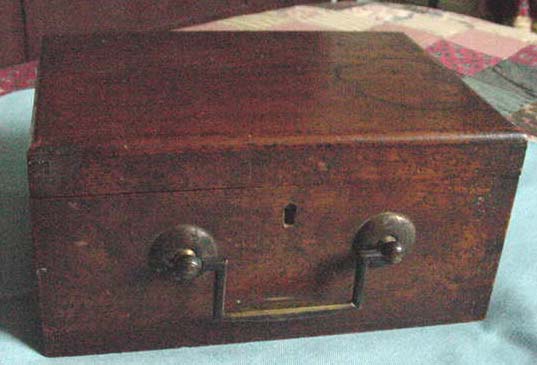
51g ** The front of the box of the Palmer & Hall
Telegraph Set.
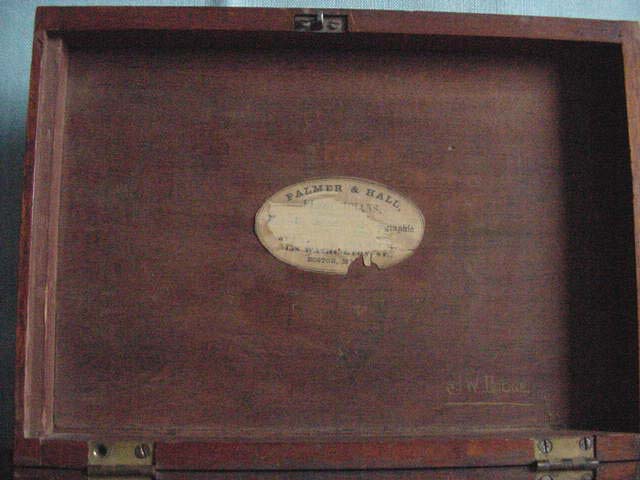
51h ** The inside of the cover of the box of the
Palmer & Hall Telegraph Set showing the Palmer and Hall paper label.
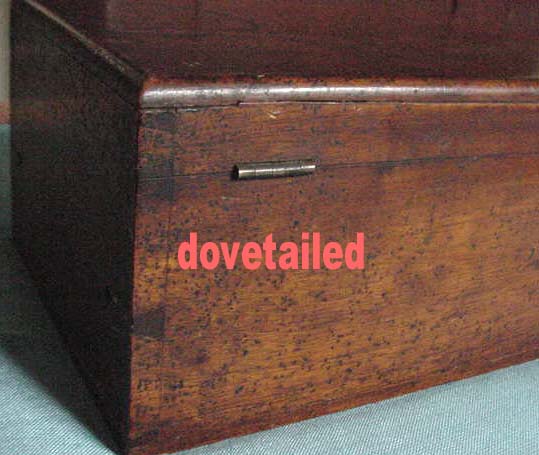
51i ** A close view of the dovetailed corner of the
box of the Palmer & Hall Telegraph Set.

52 ** EXTREMELY EARLY TELEGRAPH AND MINSTREL AMBROTYPE:
(57KB)This extremely early ambrotype is from the Jim Bollman (email:
jim@themusicemporium.com ) collection of very early banjos. It is copyright
(c) Jim Bollman and it is provided courtesy of The Music Emporium
( http://www.themusicemporium.com ).
Ambrotypes were introduced after dagerreotypes and around the middle of the
19th century. They consist of a transparency which is mounted on a black
background. This one shows a grouping of 8 young boys with a banjo and two
telegraph instruments. The grouping and banjo indicate that these boys are
members of one of the popular minstrel groups of the mid 19th century. Three
of the boys are wearing hats and at least two are wearing uniforms which
suggest that they work in a telegraph office. They are holding two extremely
early telegraph instruments and I believe that this is the earliest photograph
of these instruments that has been found.
The left instrument appears to be a Thomas Hall relay similar to the

number 68 ** Palmer & Hall relay shown in my museum:(16KB)
The right instrument appears to be a similar Hall relay mounted on the same
board with a very curved telegraph key which may be an Hall or some other key.
If it is an Hall key, it is much earlier and more elaborate than the
number 67 Hall telegraph key in my
museum:(15KB)
Click here to see an enlarged (but very
slow loading) view of this entire picture:(191KB)
I have selected the
right instrument and enlarged it to allow much closer inspection.
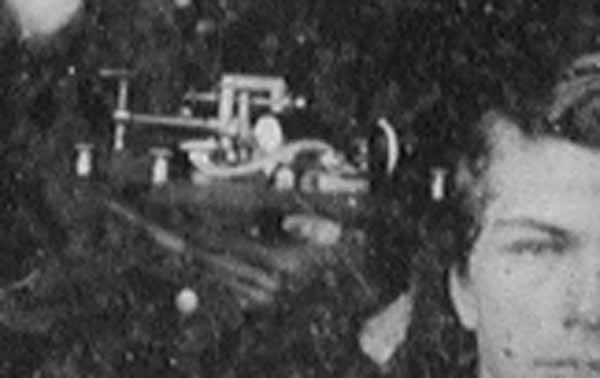
This is an enlarged view
with no sharpening:(17KB) It reveals that the key has a light-colored
probably ivory knob.
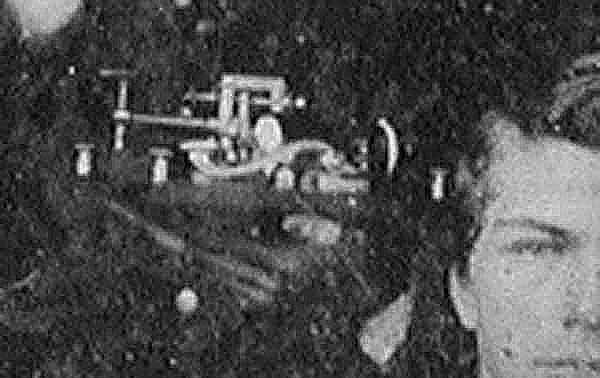
Adding a very high degree of sharpening allows a few more
details to be seen:(26KB)
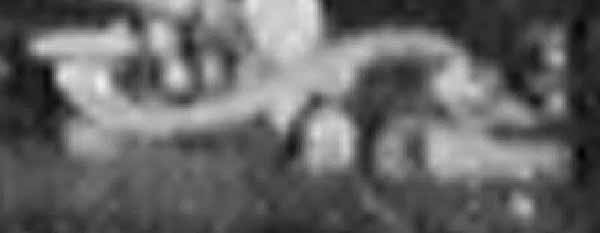
Still more enlargement:(8KB) starts to show more
additional details of the key's design. However, you will probably have
to step quite far back away from your computer screen to view it.
CONCLUSION: I believe that the key is a Palmer and Hall camelback as
shown in
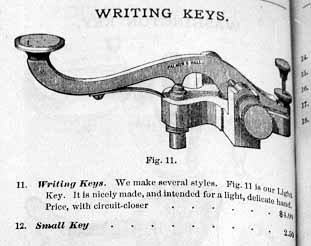
This picture from the Hall
Catalog:(12KB).
Although it is difficult to see all of the details in the ambrotype
because the head of a minstrel gets in the way, most details seem to match
the catalog illustration.
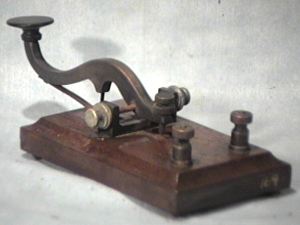
52f ** HOMEMADE MODEL OF THE PALMER & HALL
CAMELBACK:(10KB)This key is in the Tom French W1IMQ collection.
It appears to have been modeled after the above key.
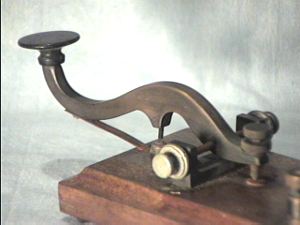
52fa ** Another view of the homemade
camelback:(11KB)
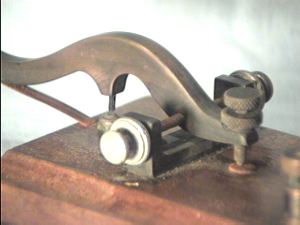
52fb ** Another view of the homemade
camelback:(11KB)
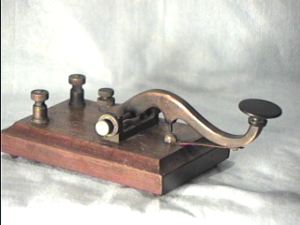
52fc ** Another view of the homemade
camelback:(10KB)
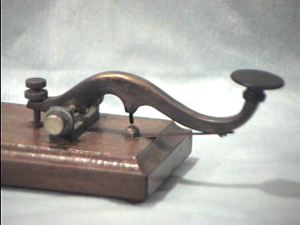
52fd ** Another view of the homemade
camelback:(10KB)
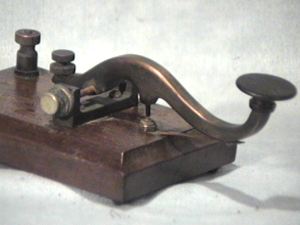
52fe ** Another view of the homemade
camelback:(10KB)
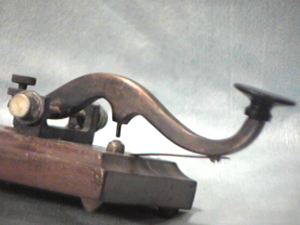
52fg ** Another view of the homemade
camelback:(11KB)
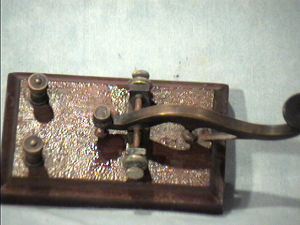
52fh ** Another view of the homemade
camelback:(14KB)

53 VERY EARLY PALMER AND HALL OR HALL BOXED PORTABLE
COMBINATION TELEGRAPH KEY AND RELAY SET:
This extremely rare portable telegraph set is enclosed in a strong wooden box
that protects the tiny miniature straight lever key and miniature relay
from damage. The overall design and the spring adjusting mechanism for the
relay is quite unusual. Although there are no obvious markings on the set,
the knurling on the hardware, the shape of the parts, and the design strongly
suggest that it was made by Palmer and Hall or Hall in Boston, Mass.
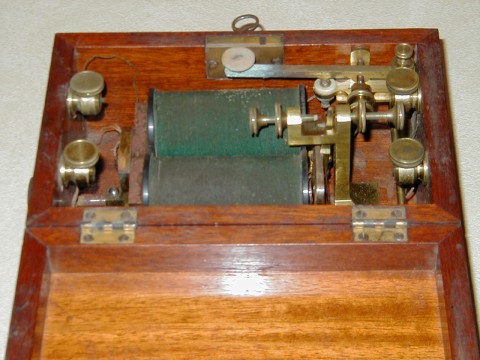
53a Another view of the Palmer and Hall portable
set:
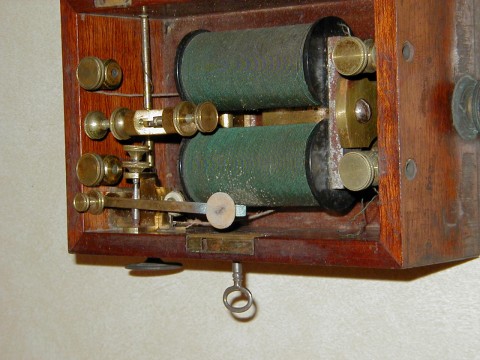
53b Another view of the Palmer and Hall portable
set:
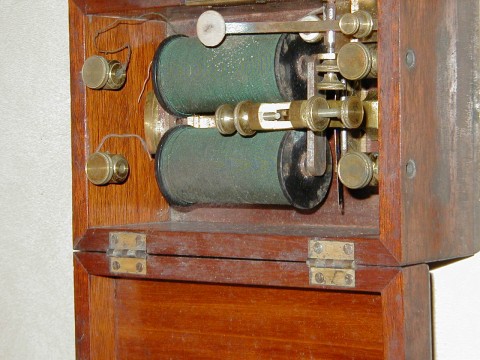
53c Another view of the Palmer and Hall portable
set:
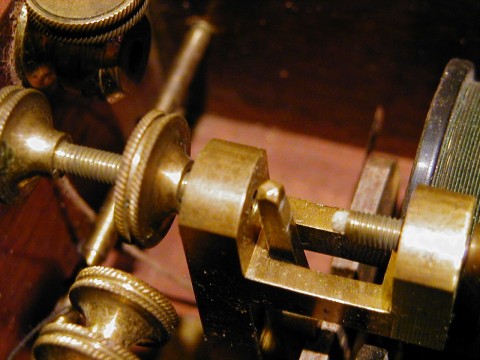
53d A closer view of the mechanism of the
Palmer and Hall portable set:
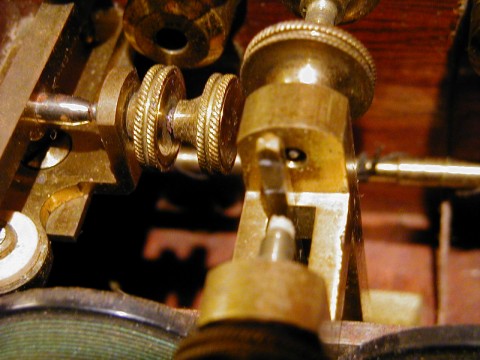
53e A closer view of the mechanism of the
Palmer and Hall portable set:
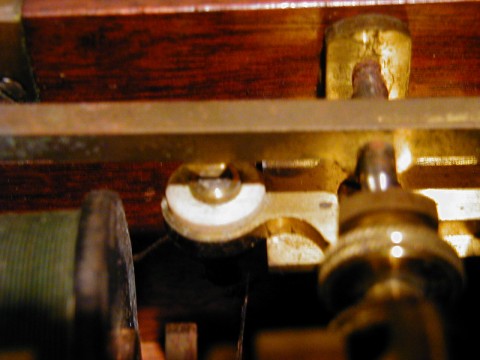
53f A closer view of the key in the
Palmer and Hall portable set:
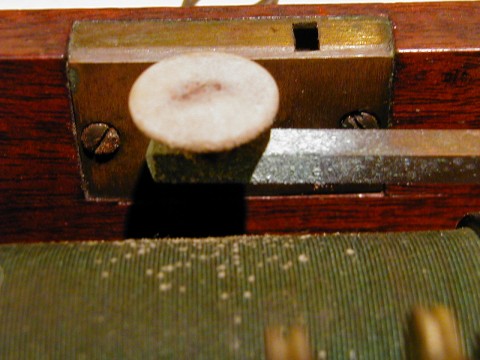
53g A closer view of the key in the
Palmer and Hall portable set:
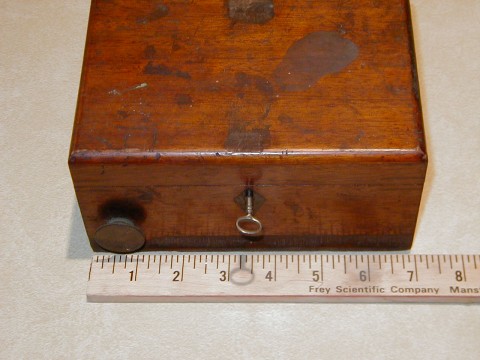
53h The front outside of the box of the
Palmer and Hall portable set:
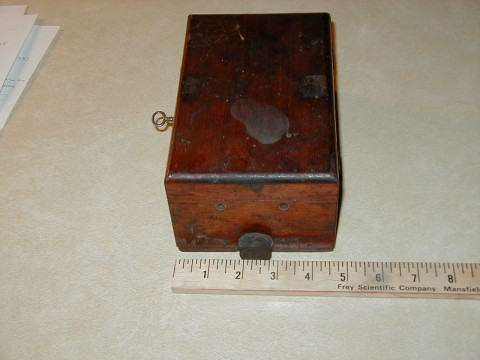
53i The right outside of the box of the
Palmer and Hall portable set:
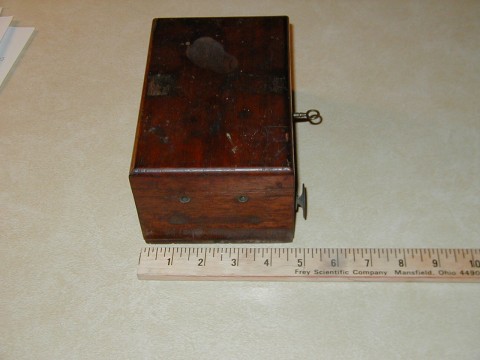
53j The left outside of the box of the
Palmer and Hall portable set:
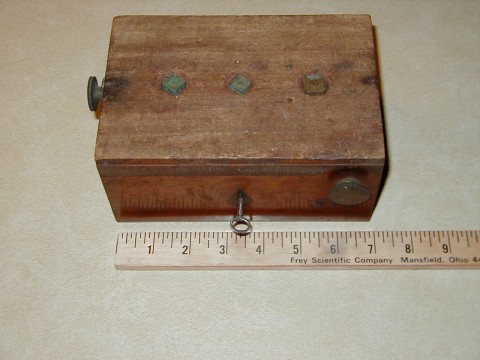
53k The bottom of the box of the
Palmer and Hall portable set:
54 ** POSSIBLY THE EARLIEST TELEGRAPH DAGUERREOTYPES:
These daguerreotypes are exhibited with the permission of Mark Koenigsberg
whose daguerreotype museum at: http://www.geocities.com/~daguerreotype
contains many other early pictures on other subjects. They are
copyright (c) Mark Koenigsberg and are the earliest images of
telegraphers and telegraph instruments that I have found.

55 EXTREMELY EARLY CATON 'MORSE'
WEIGHT-DRIVEN REGISTER:(54KB)
This extremely early Morse Register is a fine example of the first
style of paper-tape recorder to be used on the telegraph lines. It
is powered by a weight and pulls a paper tape past a stylus that
makes indentations in the tape for dots and dashes. It was used
in a railroad depot in Stockton Springs, Maine. It was acquired by
James Coose (W1CBU) of Stockton Springs when the station closed and
given to his son-in-law Robert Littlefield (W1MFU) and transferred
to this museum by Diane Coose Littlefield in 1996. It was made by the
Caton Instrument Co. in the 1850's.
The base is stamped: OTTAWA - ILL 433.
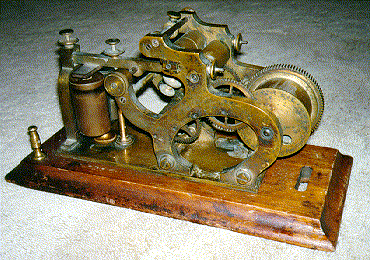
55b ANOTHER VIEW OF THE CATON 'MORSE'
REGISTER:(54KB)
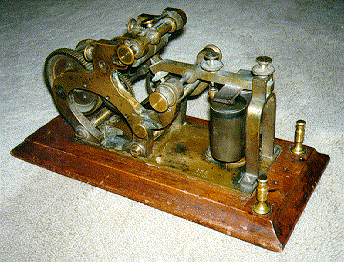
55c ANOTHER VIEW OF THE CATON 'MORSE'
REGISTER:(54KB)

56 CATON TELEGRAPH KEY:(12KB)
This early straight lever key was made by the Caton Instrument Co.,
Ottawa, Ill. The long legs pass through holes in the operating table
and wires are attached to binding posts at the end of each leg.
The lever is stamped CATON, OTTAWA, ILL 7?? (illegible),
and the base is stamped with the number 494. Circa 1860's.

57 ** EARLY CATON 'LINEMAN'S TEST SET OR POCKET
RELAY:(18KB)This magnificent pocket relay or 'lineman's test set'
consists of a sensitive sounder and a very early and tiny strap key.
There is a tiny ivory knob on both the key and the shorting lever.
These sets allowed linemen to tap into telegraph lines with a pocket-sized
instrument and they were also used by the military for intercepting and
sending false messages to the enemy. The set is enclosed in an
oval hard rubber case and in a thick leather protective case.
These pocket sets are very hard to find and this one is owned
by collector Bill Carpenter, AA8EY.
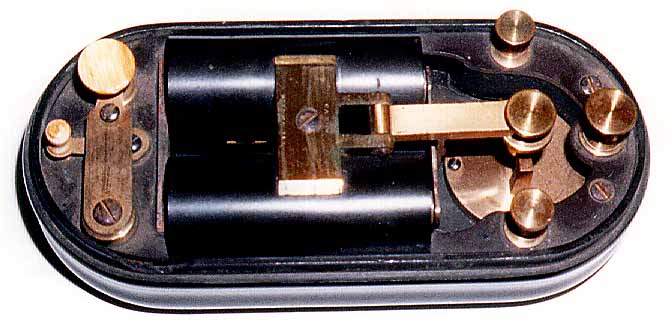
57a High Resolution picture of the Caton Pocket
Relay:(48KB)
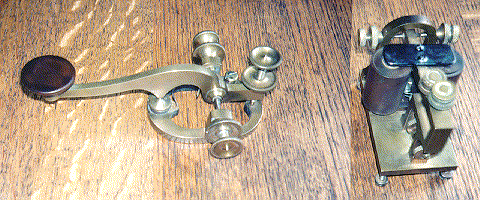
60 VERY EARLY ELABORATE CAMELBACK KEY & SOUNDER:(63KB)
This all brass key with leaf spring has a massive elaborately curved
lever of the earliest "camelback" or "humpbacked" shape which was
adopted soon after Morse's demonstration. These keys were only made
for a short time because the steel shaft, press fit into the lever,
tended to work loose with use. The sounder is also heavy brass but,
although it was mounted on a board along with this key, I believe that
the sounder may be from a later period. The original wooden base is
missing. The two instruments came from a burned railroad
station in Canada. Circa 1848. The lever shape and large dished
adjusting screw heads are very similar to the two keys shown below.
It has been suggested that these keys were all made by the Dominion
Telegraph Company in Canada but unfortunately, we have very little
information about Canadian Telegraph Companies.
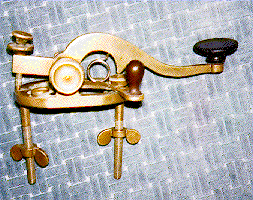
62 VERY EARLY ELABORATE CAMELBACK KEY:(32KB)
This all brass key with early hairpin spring has the same massive
elaborately curved lever as number 210. The hairpin spring suggests
that it is of a slightly later design. It is stamped NWT, the
initials of the early Northwest Telegraph Company of Western Canada.
All underside parts are stamped "2" and it is also stamped 1880., an
inventory date? It came from Canada. Circa 1850.

63 VERY EARLY ELABORATE STRAIGHT LEVER KEY:(32KB)
This extremely early all brass straight lever key is very similar to
the two extremely early camelback keys above. Note that the shorting
lever and adjusting screws are virtually identical to those above.
Like the two camelbacks, it was also located in Canada and it may have
been made by the Dominion Telegraph Company. Circa 1850's. Collector
Pete Malvasi, W2PM owns a sounder which appears to match this key and which is
labeled Dominion Tel Co. and this lends credence to the suggestion that
Dominion made this key although the key below is very similar to this key and
carries the label: FOSTER, Toronto suggesting that this key might have been
made by Foster.
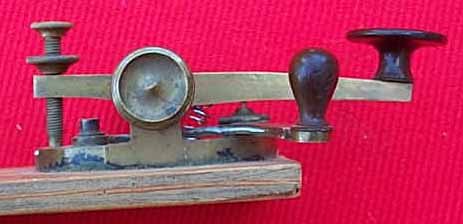
63a Another view of the early straight
lever key:(16KB)
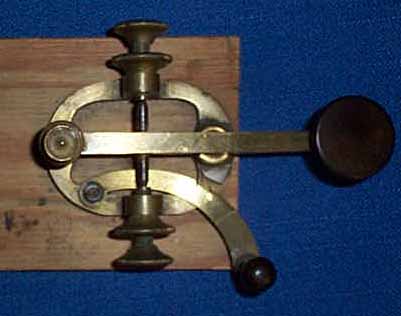
63b A closer view of the early straight
lever key:(16KB)
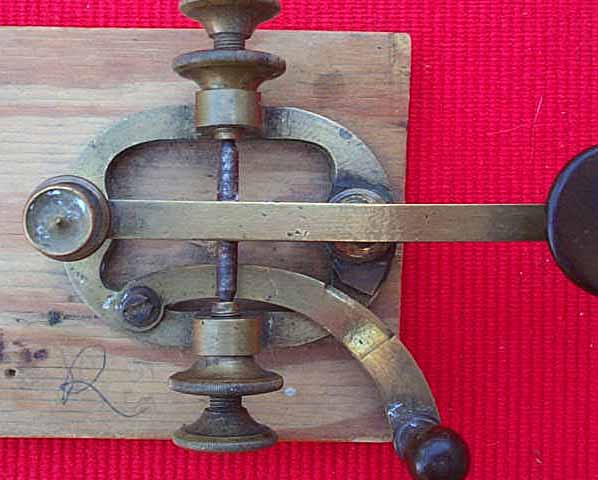
63c A still-closer view of the early
straight lever key:(32KB)

64 VERY EARLY ELABORATE CANADIAN 'FOSTER'
STRAIGHT LEVER KEY {One Mystery Solved!}:(32KB)
This extremely early all brass straight lever key is very similar to the key
above (Number 0063). Note that the shorting lever and adjusting screws are
virtually identical to those above. This key is labeled: FOSTER, TORONTO and
it appears to be a very early key made in the 1850s. Several keys have
turned up in the last 10 years that are similar to this key but none of them
has carried a maker's name. It is apparent that this key solves the mystery
of who made these other keys by showing that it was "FOSTER" of Canada who
made them.
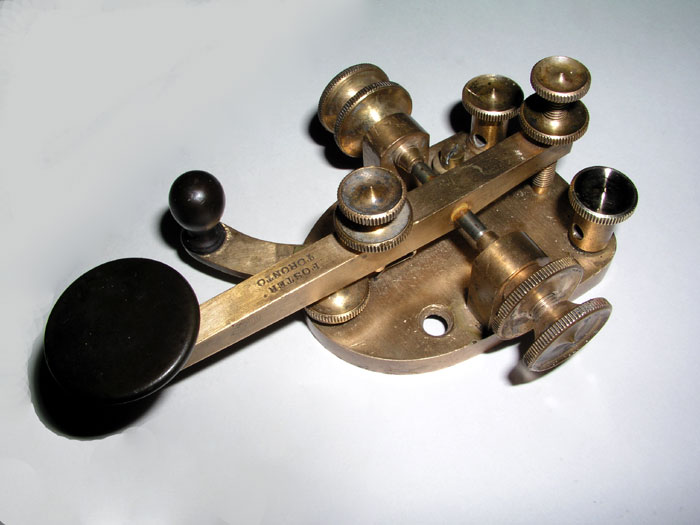
64a Another view of the very early Foster straight
lever key:(16KB)
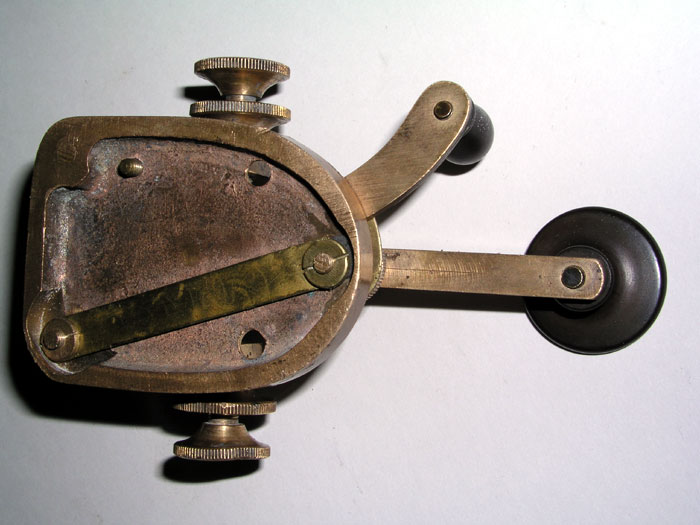
64b A view of the underside of the base of the very
early Foster straight lever key:(16KB)

65 * 1850 TELEGRAM AND TAPE FROM A ''HOUSE PRINTING
TELEGRAPH'':(14KB)
This telegraph message was printed on the paper tape
by a 'House Printing Telegraph' instrument in 1850. The 'House' was
first patented in 1848. The tape was delivered to the addressee
in the envelope which carries the date of receipt of the message.
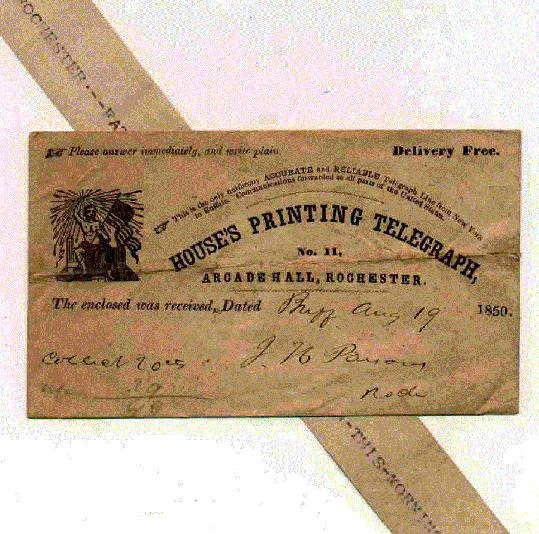
65l Higher Resolution View of the telegram:(70KB)

66 VERY EARLY THOMAS HALL WEIGHT DRIVEN REGISTER:
(24KB) This lovely old register was made by Thomas Hall of
boston in the early 1850's.
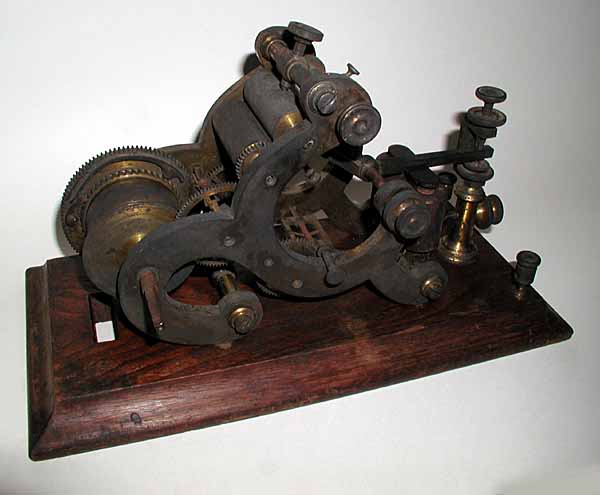
66a Another view of the Hall Register:(28KB)
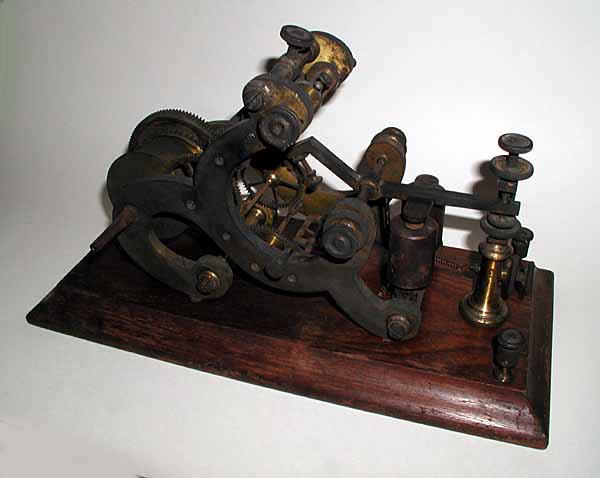
66b Another view of the Hall Register:(26KB)
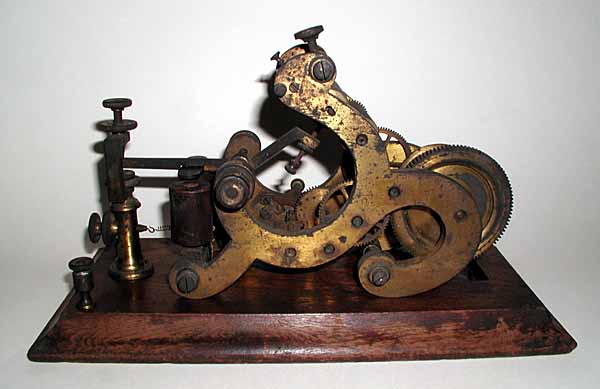
66c Another view of the Hall Register:(28KB)
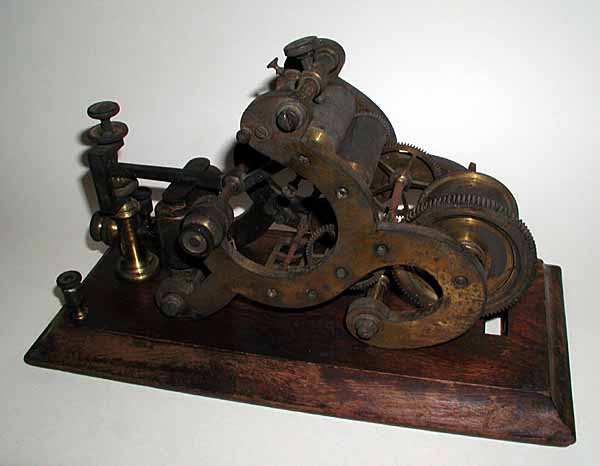
66d Another view of the Hall Register:(26KB)
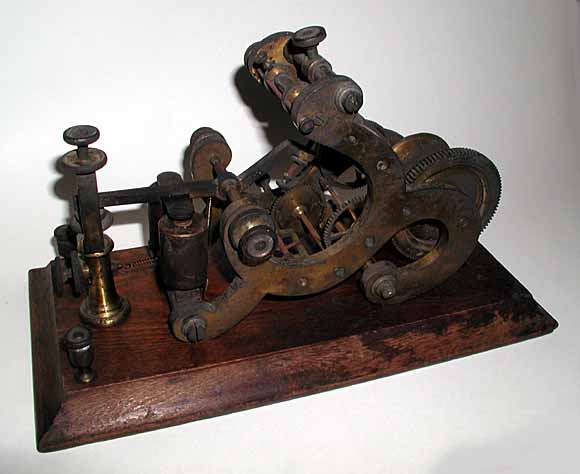
66e Another view of the Hall Register:(27KB)
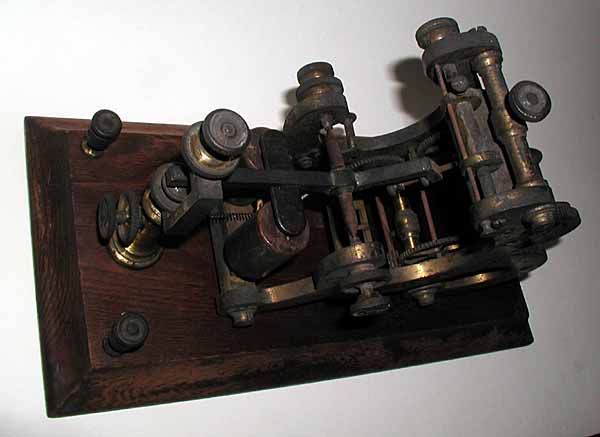
66f Another view of the Hall Register:(25KB)
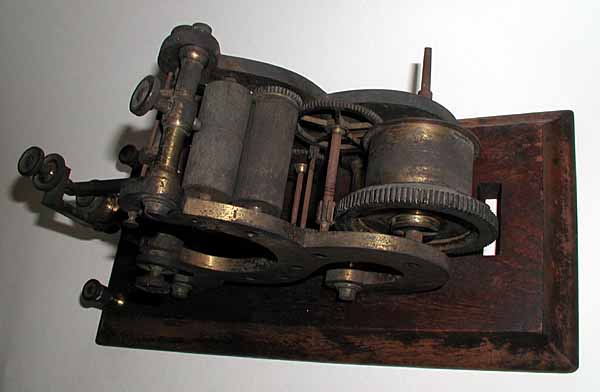
66g Another view of the Hall Register:(23KB)

67 VERY EARLY THOMAS HALL CAMELBACK KEY:(15KB)
This lovely camelback key was made by Thomas Hall of Boston circa
the 1850's.
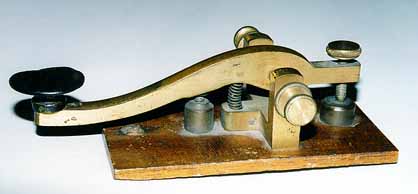
67a The other side of the Hall
camelback:(15KB)

68 * VERY EARLY PALMER & HALL RELAY:(20KB)
This lovely early relay was made by the firm of Palmer & Hall of
Boston sometime between 1847 and 1849. Notice the ivory end caps on
each of the coils and the ivory insulator on the very end of the contact
spacing screw.(Traded to W2PM)
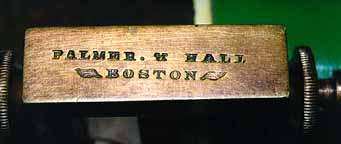
68a *
Closeup of the Name on top of the frame:(11KB)

69 VERY EARLY THOMAS HALL SOUNDER:(26KB)
This lovely early sounder was made by the firm of Thomas Hall of
Boston sometime between 1847 and 1859.
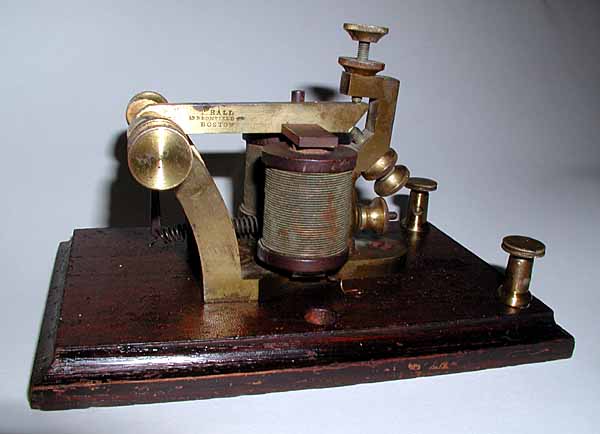
69a Another view of the Thomas Hall Sounder:(28KB)
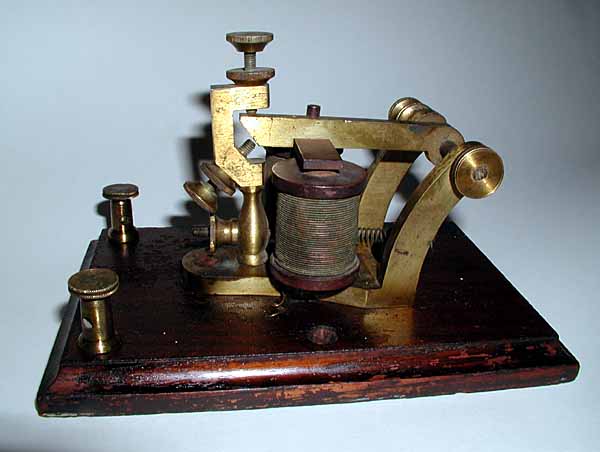
69b Another view of the Thomas Hall Sounder:(30KB)

70 VERY EARLY CHARLES CHESTER WEIGHT-DRIVEN MORSE REGISTER:(18KB)
This very early register was made by Charles T. Chester of New York in
the 1850's. It is an embossing register which means that it marked
dots and dashes by making impressions in the paper tape rather than
by depositing ink on the tape.
A pair of them was originally purchased and one was traded.
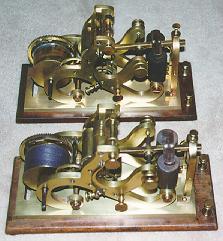
70a The Pair of Chester Registers:(17KB)
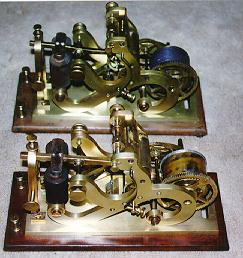
70b The Pair of Chester Registers-(other side):(20KB)

71 VERY EARLY CHARLES CHESTER TELEGRAPH KEY:(12KB)
This lovely straight lever key was manufactured by Charles T. Chester
of New York in the 1850's or 1860's. The lever is 5" long and the base is
3".

72 VERY EARLY MINIATURE CHARLES CHESTER TELEGRAPH KEY:(11KB)
This is a smaller version of number 71. The lever is 4" long and the
base is 2" long.

74 * VERY EARLY TILLOTSON WEIGHT-DRIVEN REGISTER:(45KB)
This lovely and very early register was made by Tillotson & Co of New York in
the 1850's. It's design appears to be identical to the Knox & Shain Registers
made in Philadelphia. It is an embossing register which records dots and
dashes on the paper tape by making indentations in the tape with a pointed
stylus. This picture is displayed with the permission of the
owner/collector.

75 * VERY EARLY CHUBBUCK WEIGHT-DRIVEN REGISTER:(24KB)
This very early register was made by Chubbuck in Utica, NY in the 1850's.
It is an embossing register which records dots and dashes on the
paper tape by making indentations in the tape with a pointed stylus.
(traded to K5VT)
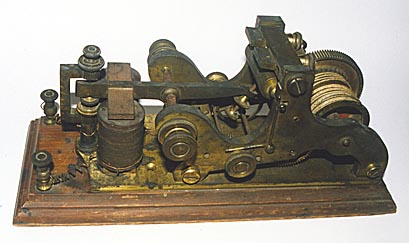
75a ANOTHER VIEW OF THE CHUBBUCK REGISTER:(25KB)

76 VERY EARLY CHUBBUCK WEIGHT-DRIVEN REGISTER:(29KB)
Very similar to number 75 above.
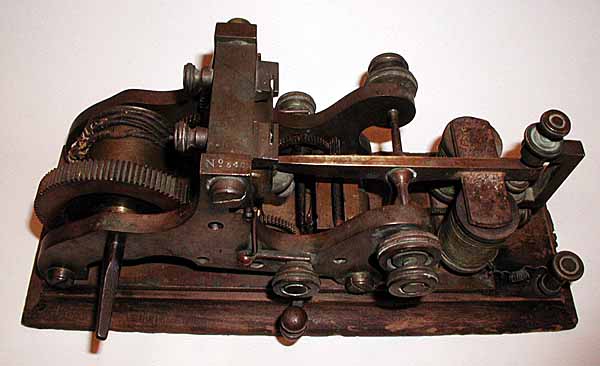
76a ANOTHER VIEW OF THE CHUBBUCK REGISTER:(31KB)
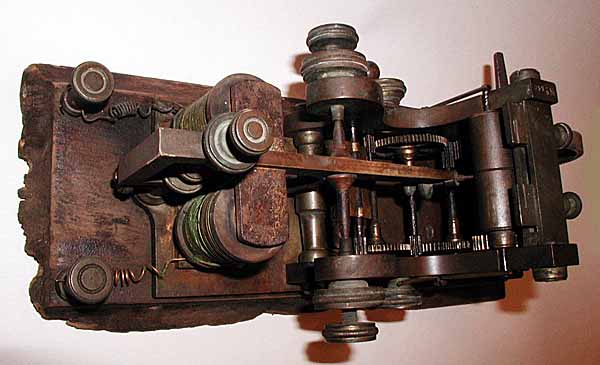
76b ANOTHER VIEW OF THE CHUBBUCK REGISTER:(35KB)
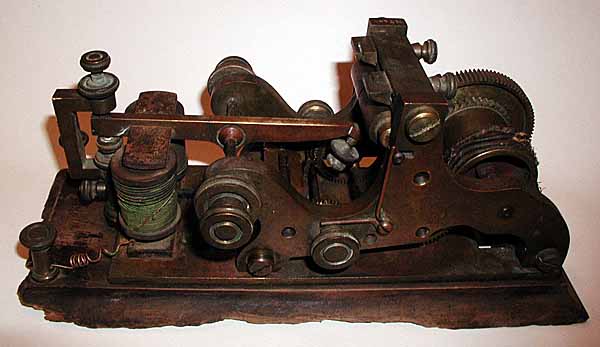
76c ANOTHER VIEW OF THE CHUBBUCK REGISTER:(30KB)
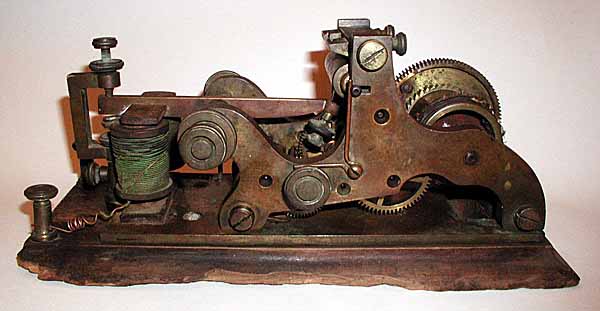
76d ANOTHER VIEW OF THE CHUBBUCK REGISTER:(30KB)

79 EARLY WESTERN UNION WEIGHT-DRIVEN REGISTER:(22KB)
This is an early Western Union Weight-Driven Register. The
solid brass sides of the string reel are very unusual. It is an embossing
register which marks dots and dashes on the paper tape by making
indentations in the tape with a pointed stylus.
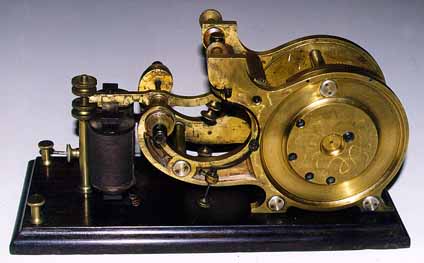
79a ANOTHER VIEW OF THE WESTERN UNION REGISTER:(22KB)
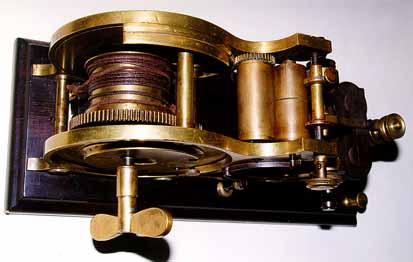
79b TOP VIEW OF THE WESTERN UNION REGISTER:(21KB)
The register was apparently carried from location to location in this box.
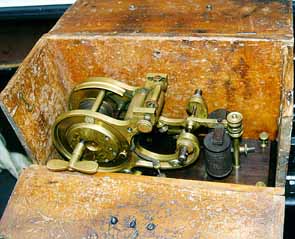
79c WESTERN UNION REGISTER BOX OPEN:(23KB)
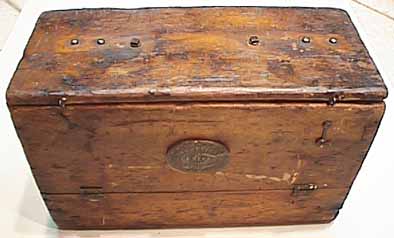
79d WESTERN UNION REGISTER BOX CLOSED:(20KB)
The box has the Western Union Label on the front:
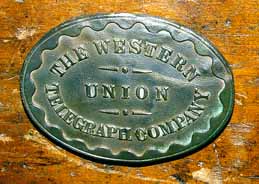
79e WESTERN UNION REGISTER BOX LABEL:(20KB)

80 CIVIL WAR ERA PHELPS CAMELBACK KOB,
Marked G.M.PHELPS-MAKER.:(27KB)
These Phelps Camelback keys were the most widely used of the Civil War keys.
Camelback keys have an upward lump like a camel's hump on the lever
between the knob and the pivot. They were only made for about 12 years
from 1853-1865 because the steel trunnion shaft which was press-fit
into the lever would gradually work loose with prolonged use.
The brass lever would then slide left and right making the key unusable.
This key is all brass except for the steel trunion shaft. The key has a
shorting switch and the revolutionary Phelps-invented spring adjusting
screw which was copied and used on just about every key manufactured
after his invention. This particular Phelps key is mounted on
wooden base with its legs shortened to fit into the base. (a common
but unfortunate modification.) A very early
and primitive Tillotson sounder is also mounted on the base making
it into a portable Key (and sounder) On Base, commonly called a
KOB.(1860's)

81 * CAMELBACK LEG KEY: G.M.PHELPS-MAKER.:(10KB)
As above (no base).circa 1860's.(Traded to John Casale - W2NI.)
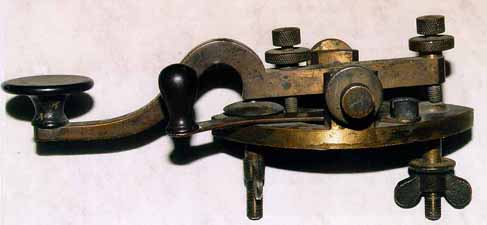
81a Another view of the Phelps key:(16KB)
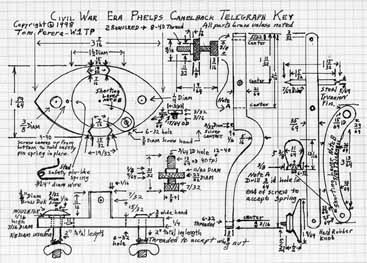
CONSTRUCTION PLANS FOR A PHELPS CAMELBACK
KEY:(LOW RESOLUTION): (35KB)
I have often been asked for drawings of the historic Phelps
Camelback Keys by Civil War Reenactors and others who are
interested in making replicas. I have traced a Phelps key
onto 1/4-inch squares graph paper and added the dimensions as best
my shaky hands would allow and I hope that there is enough information
to allow people to build a key from these plans. I offer these plans
in low, medium, and high levels of resolution. They are
copyrighted but single copies may be made and printed for individual
use by any interested person. I would really appreciate seeing
pictures of your completed or in-progress keys!!
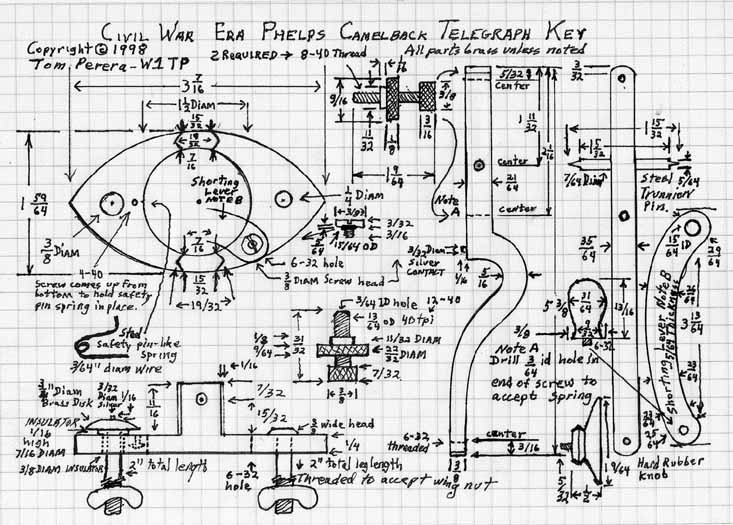
81cm CONSTRUCTION PLANS FOR A PHELPS CAMELBACK KEY:
(MEDIUM RESOLUTION): (96KB)
81cl CONSTRUCTION PLANS FOR A PHELPS
CAMELBACK KEY: (HIGH RESOLUTION): (403KB)
The following photographs show many views of a Phelps Key and may be
useful to those who are trying to reproduce one:

82 PHELPS CAMELBACK KEY (Left Top View mounted on
a base:(21KB)
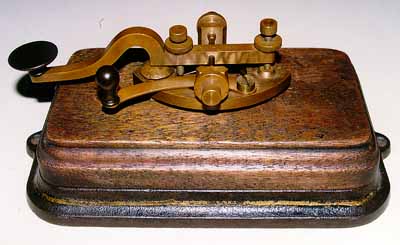
82a PHELPS CAMELBACK KEY (Right Top View mounted on
a base:(22KB)
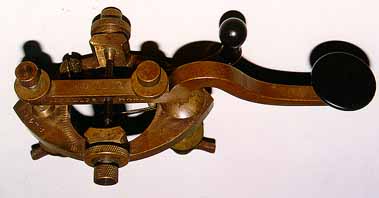
82b PHELPS CAMELBACK KEY (Left Top View
unmounted:(14KB)
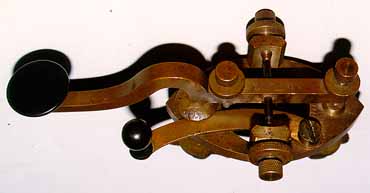
82c PHELPS CAMELBACK KEY (Right Top View
unmounted:(13KB)
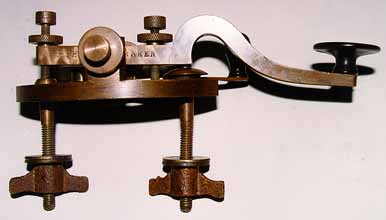
82d PHELPS CAMELBACK KEY (Left Side View
unmounted:(13KB)
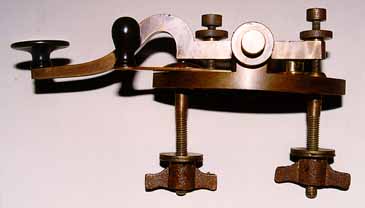
82e PHELPS CAMELBACK KEY (Right Side View
unmounted:(14KB)
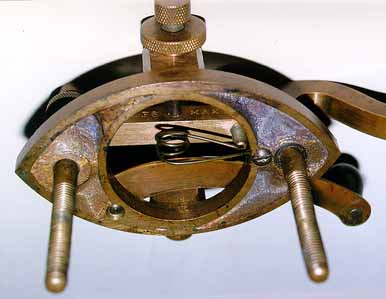
82f PHELPS CAMELBACK KEY (Bottom View
unmounted:(21KB)
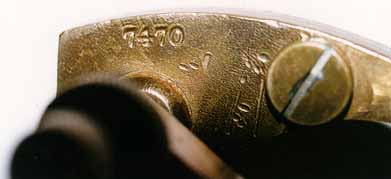
82g PHELPS CAMELBACK KEY (Serial Number on top
of base:(12KB)
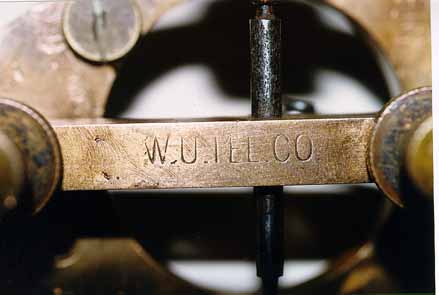
82h PHELPS CAMELBACK KEY (W.U.TEL.CO Stamped on
top of lever:(18KB)
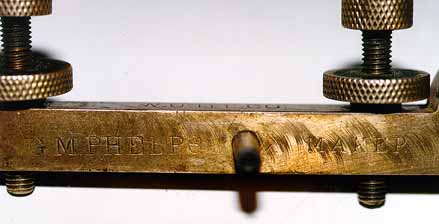
82i PHELPS CAMELBACK KEY (G.M.PHELPS MAKER Stamped
on left side of lever:(18KB)

83 VERY UNUSUAL AMERICAN TELEGRAPH CO. PHELPS
CAMELBACK KEY (G.M.PHELPS MAKER Stamped on left side of lever)
WITH SIDE MOUNTED SHORTING CONTACTS:(14KB)This Phelps
Camelback key is stamped AM. TEL. CO. on top of the lever. It has
an extremely unusual shorting switch with spring-loaded detent
and side mounted contacts. It was found mounted on a wooden board
with an early sounder of unusual design. The following photos show
all of the unusual aspects of the key:
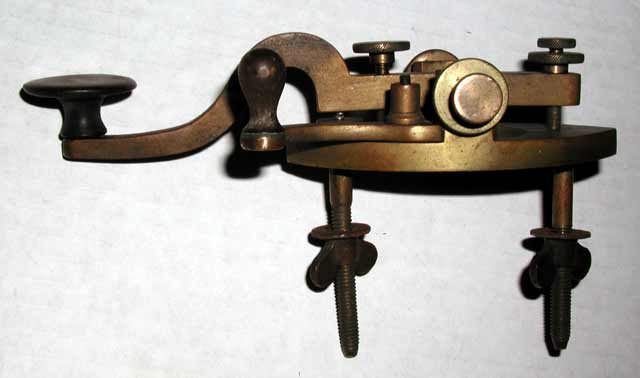
83a A view of the Right side of the key showing
the unusually thick shorting lever:(17KB)
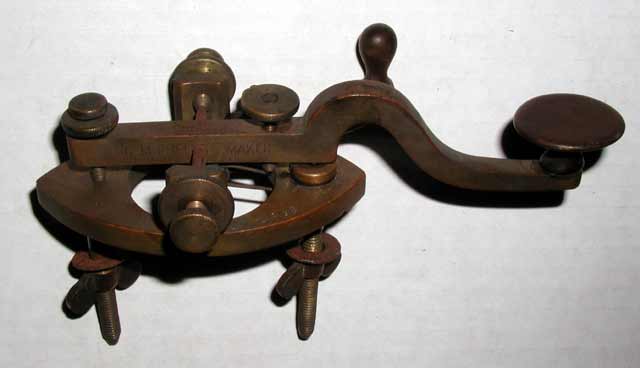
83b A view of the Left side of the key showing
the G.M.PHELPS MAKER Stamped into the lever:(14KB)
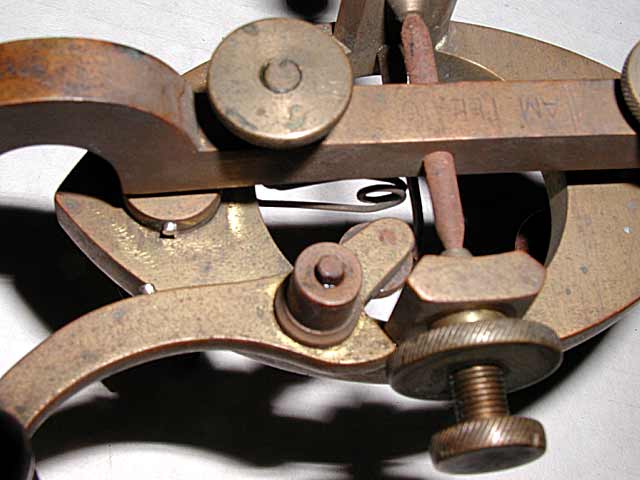
83c A closeup view of the side-mounted shorting
lever contacts in the open position showing the spring and roller
detent:(31KB)
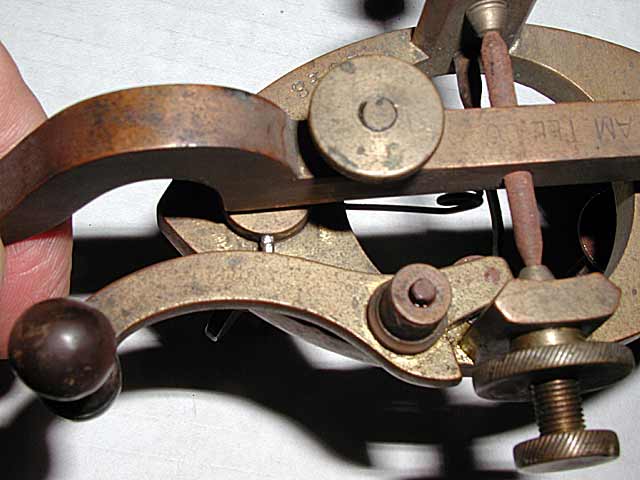
83d A closeup view of the side-mounted shorting
lever contacts in the closed position showing the spring and roller
detent:(34KB)
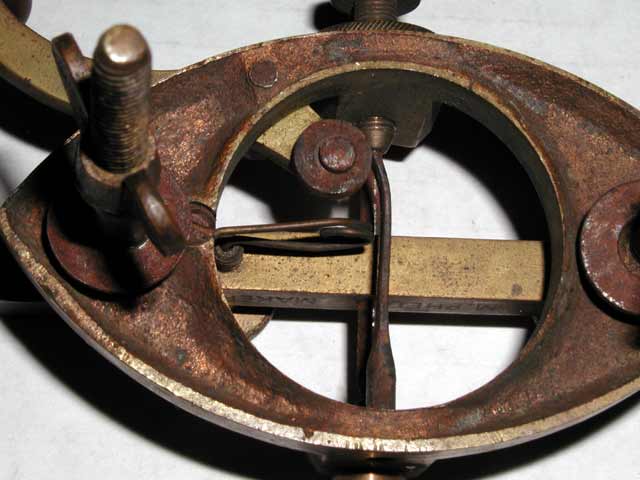
83e A closeup view of the bottom of the key showing
the shorting lever mechanism in the open position:(33KB)
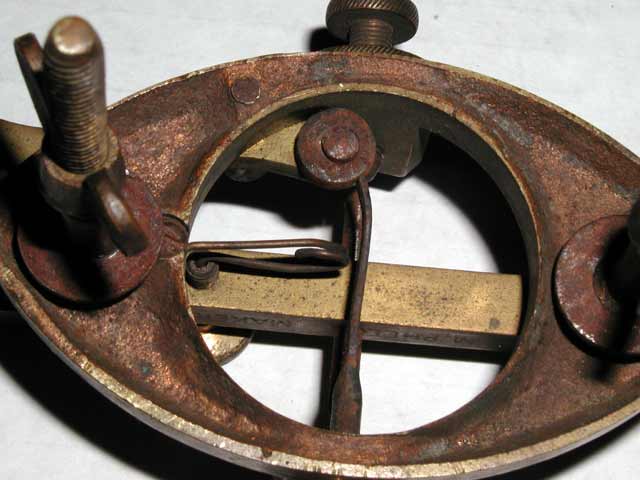
83f A closeup view of the bottom of the key showing
the shorting lever mechanism in the closed position:(33KB)
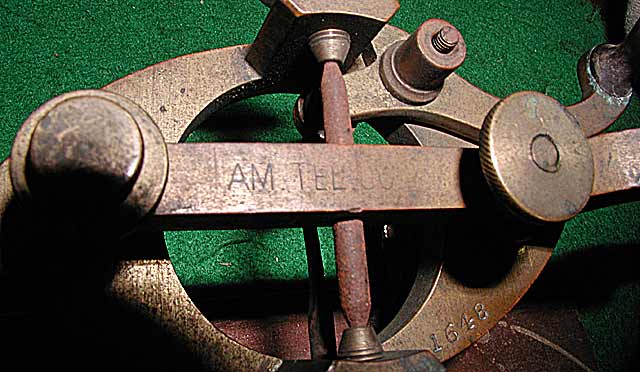
83g A closeup view of top of the lever showing
the AM. TEL. CO. stamp:(43KB)
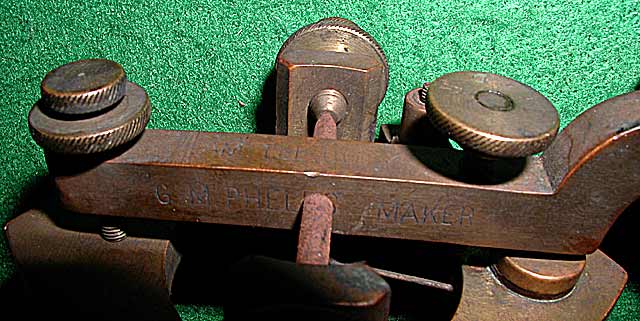
83h A closeup view of left side of the lever showing
the G.M.PHELPS MAKER stamp:(46KB)
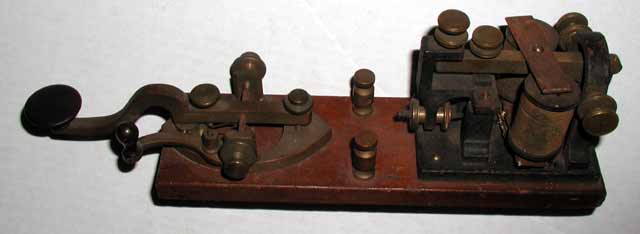
83i Right side of board with key & sounder as
found:(12KB)
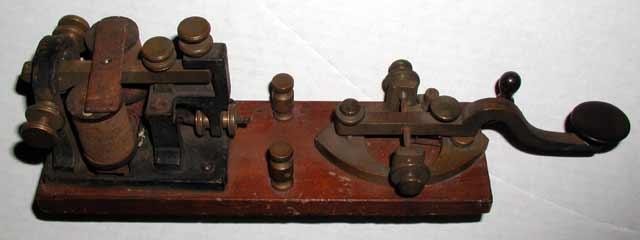
83j Right side of board with key & sounder as
found:(12KB)
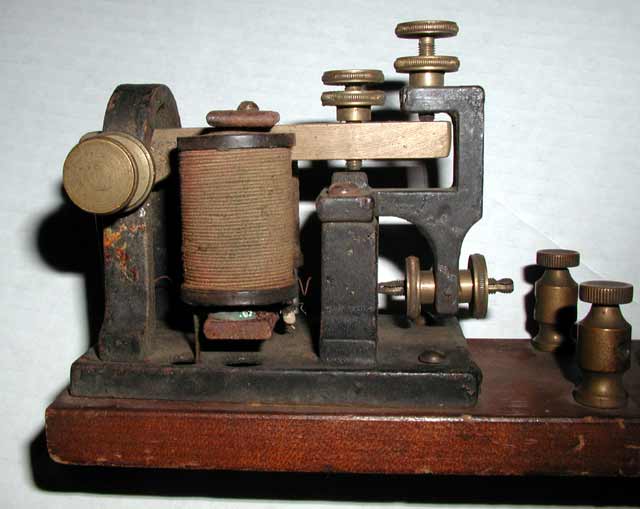
83k Side view of sounder found with key:(30KB)

85 ** PHELPS SOUNDER:(32KB)
This lovely early 1860's Phelps sounder is in the Pete Malvasi - W2PM collection.

86 * PHELPS SOUNDER - RELAY:(26KB)
This Phelps sounder was made as / or converted into a relay.
The upright post is insulated from the base and forms one of
the normally-open relay contacts while a hole in one
trunnion support with a set screw for a piece of wire forms
the other part of the circuit.(Traded to John Casale-W2NI)

87 * EARLY PHELPS/WESTERN UNION PLUG-STYLE TELEGRAPH
SWITCHBOARD:(18KB)
This switchboard allowed one telegraph set to be switched
into one of two incoming telegraph lines. Tapered brass plugs
completed the circuit. A lightning arrestor plate, separated
from the conductors by a small gap, shunted lightning strikes
to ground. The plate reads: W.U.TEL.CO., G.M.PHELPS.(Traded to
John Casale - W2NI.)

90 ** CIVIL WAR TELEGRAPH OPERATOR'S TOMBSTONE WITH
KEY AND TELEGRAPH POLE:(27KB)
This tombstone was erected in honor of James Francis Leonard of
Frankfort, KY. He was a telegraph operator during the Civil
War and is credited with having discovered that the sounds made by
a register as it impressed dot and dash marks on paper tape could
be copied by ear. This led to the widespread use of sounders
for copying the Morse code although many people still insisted
on a permanent paper tape record of the messages because they
did not trust copy-by-ear. In 2004, I was sent a photo of the base of
the tombstone showing the name 'Taylor'. I do not know the significance
of this name.
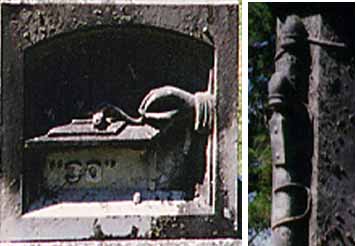
90a Closer view of the telegraph key and the
telegraph line insulator at the top of the pole:(20KB)
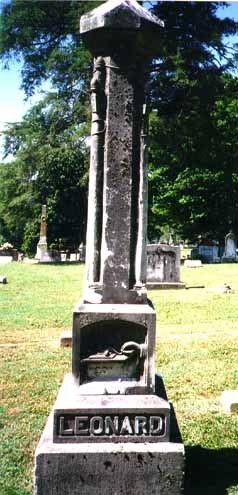
90b Closer view of the front of the tombstone:(32KB)
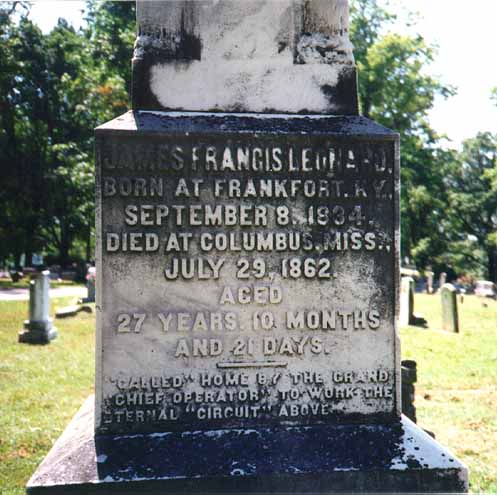
90c Closer view of the inscription:(48KB)
It reads: James Francis Loeonard. Born at Frankfort, KY.,
September 8th, 1934. Died at Columbus, Miss., July 29. 1862
aged 27 years, 10 Months and 21 Days. Called home by the Grand
"Chief Operator" To Work the "Eternal Circuit" Above.
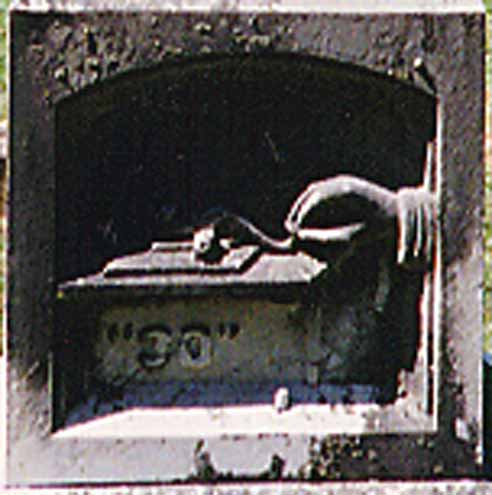
90d Closer view of the telegraph key which is
probably a Hall Camelback:(32KB)
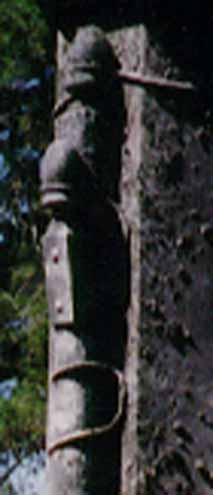
90e Closer view of the telegraph insulator:(14KB)
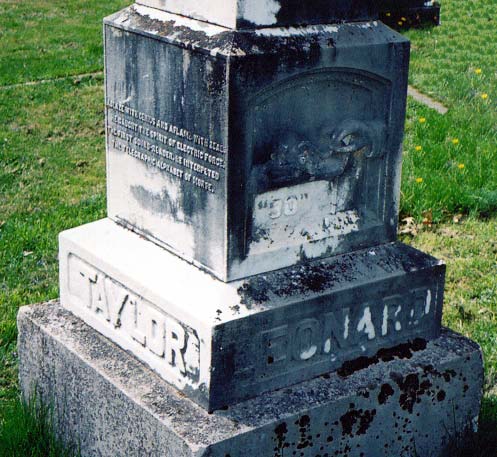
90f A different view of the tombstone showing the name
Taylor on the side of the base.

92 ** Photograph of Civil War Field Telegraph
Station:(39KB)This is one of the very few actual photographs of
a civil war field telegraph setup. You can see the large coils of the
relay quite clearly but the details of the key and other apparatus
are quite hard to make out even in the enlargement below.
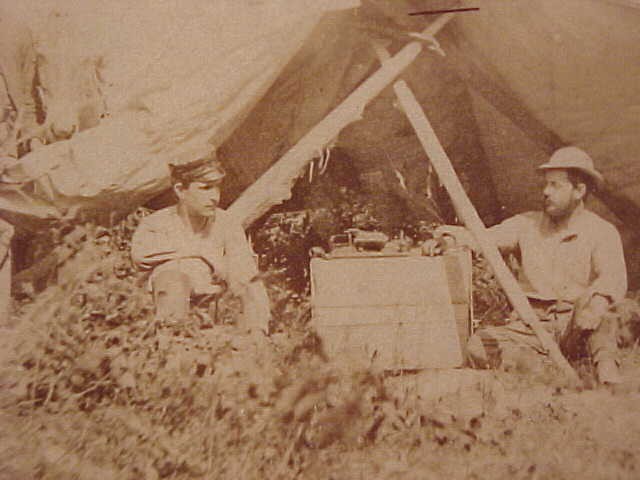
92a ** Enlarged view of the telegraph set in
the Civil War Field Telegraph Station.:(55KB)

94 VISITING CARD PHOTOGRAPH OF A TELEGRAPH OPERATOR AND
TELEGRAPH SETS:
This photograph shows a telegraph operator and what appear to be two box
relay telegraph sets with perhaps Lewis keys.

96 ** OIL PAINTING OF CIVIL WAR ERA INDIANS BURNING
TELEGRAPH POLES:(37KB)This extraordinary oil painting depicts
two indians setting fire to two telegraph poles. This was one of
the reasons that it was difficult to maintain reliable telegraphic
communications across the country at that period in American history.
This painting is the property of collector Bob Fuschetto who
was kind enough to allow me to put this photograph of it in
my museum.

99 ** CIVIL WAR REENACTOR AND TELEGRAPH HISTORIAN ROBERT
FEENEY AND HIS CIVIL WAR TELEGRAPH STATION:
Robert Feeney has been displaying, demonstrating, and explaining Civil War
Telegraph Instruments at various Civil War Reenactments. Many of his
instruments are homemade and they all function perfectly. Notice the
batteries, key & relay set, register, sounder, switch, pocket set and portable
wire dispensing reel in his display. Here are a few more photographs of his
station taken in 2006.
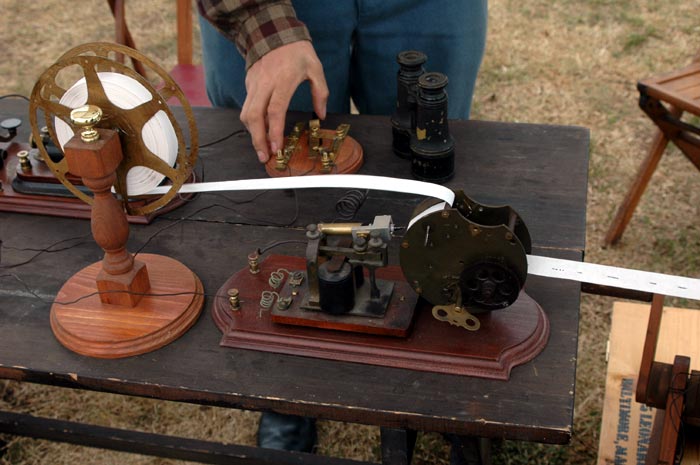
99f ** Telegraph register made by Robert Feeney for his
Civil War Field Telegraph Station:
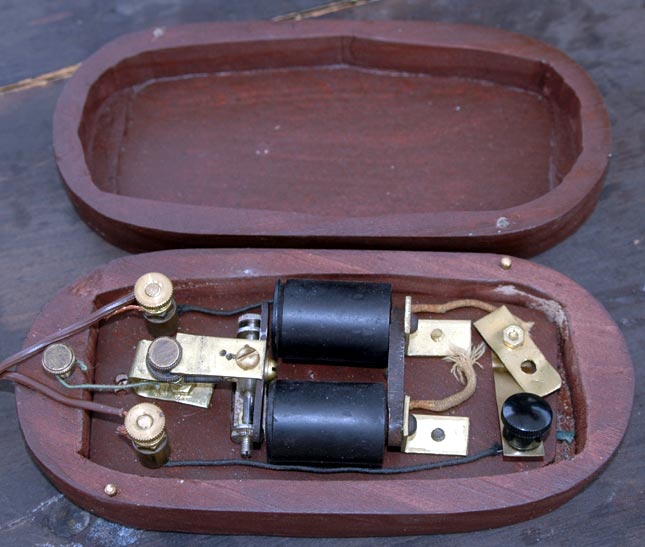
99h ** Telegraph Pocket Set made by Robert Feeney for his
Civil War Field Telegraph Station:
99s ** CIVIL WAR "U.S. MILITARY TELEGRAPH" -
TELEGRAM/MESSAGE FORM From Robert Feeney's display:(260KB)
This is the message form that was used for transcribing and delivering Civil
War Telegraph messages. It is provided courtesy of Robert Feeney. It may be
downloaded and printed on your printer. The original size is: 4-3/4 inches
wide by 7-3/16 inches high.

100 RARE MINIATURE W. HOCHHAUSEN CAMELBACK
KEY:(15KB)This tiny camelback key measures only 3-1/4 inches long.
It was manufactured in the 1870s by W. Hochhausen of New York.
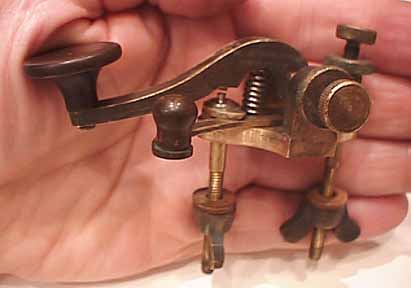
100a Another view of the W. Hochhausen
Camelback key:(14KB)
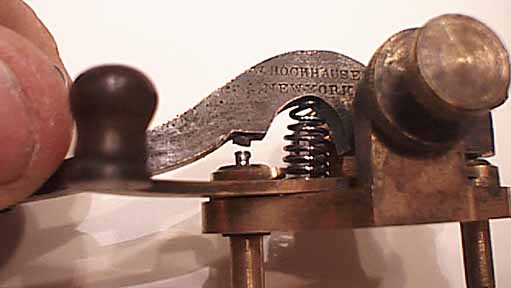
100b A close-up view of the name on the W. Hochhausen
Camelback key:(18KB)

101 RARE MINIATURE W. HOCHHAUSEN CAMELBACK
KEY and MINIATURE S. H. HOGGSON SOUNDER:(23KB)This is the same model
of Hochhausen key shown above. It was found with a miniature sounder made
by S. H. Hoggson of New Haven, Connecticut. Additional pictures are shown
below:
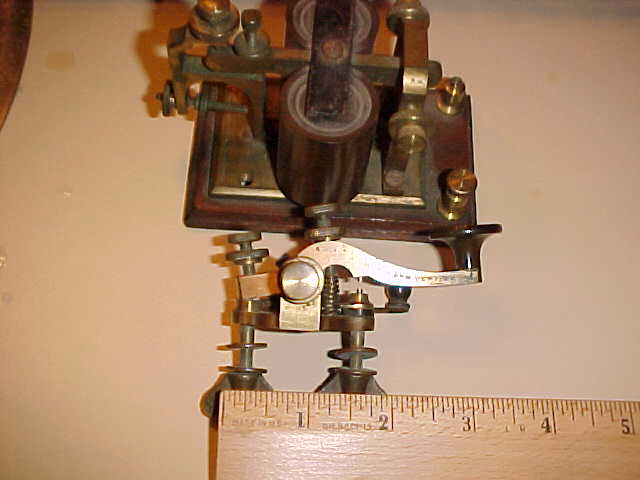
101a Hochhausen Key and Hoggson Sounder with ruler for size
reference:(23KB)
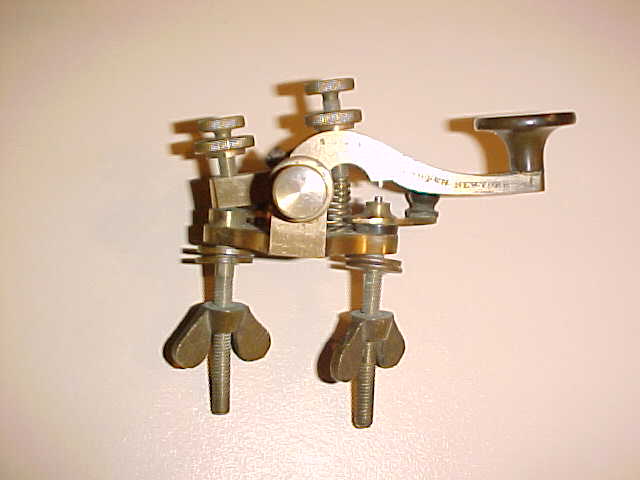
101b Left side view of the key:(25KB)
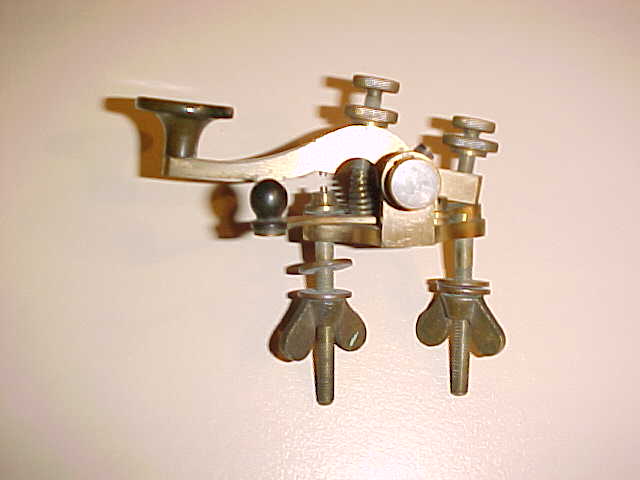
101c Right side view of the key:(20KB)
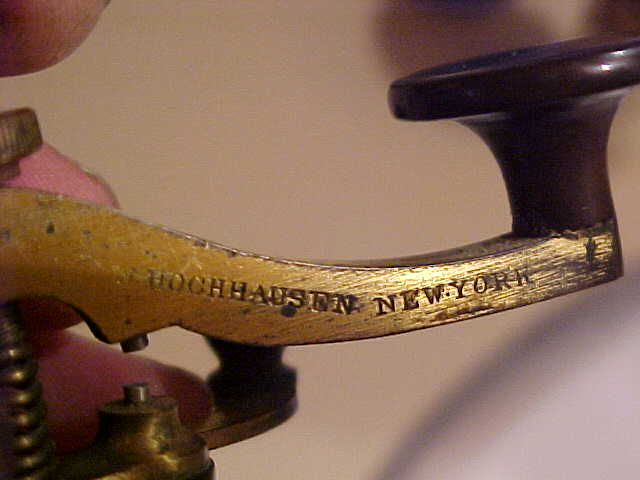
101d Closeup of name on key lever:(24KB)
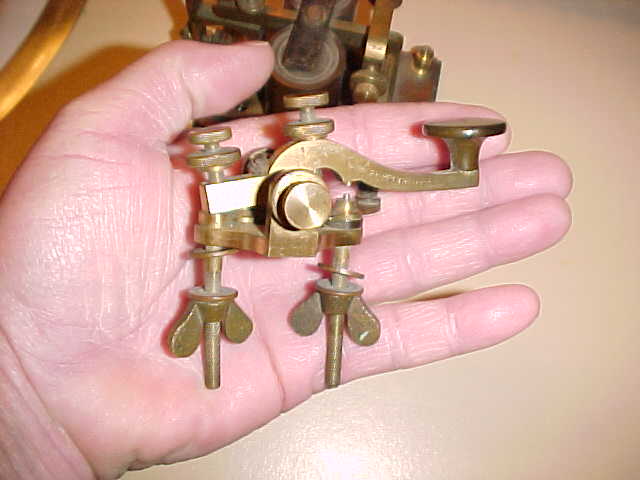
101e Key in hand for size reference:(27KB)
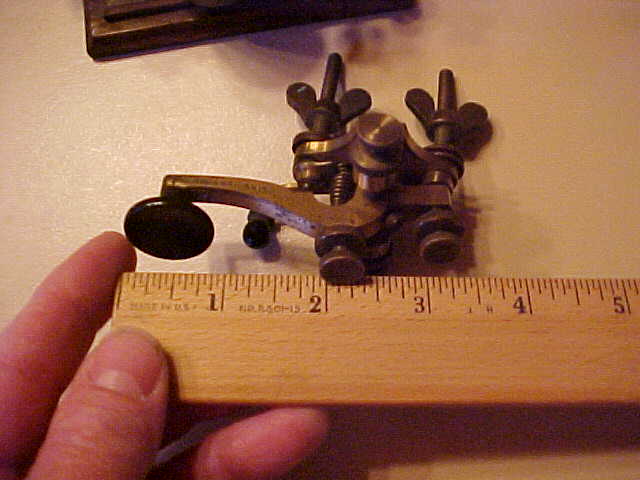
101f Key with ruler for size reference:(31KB)
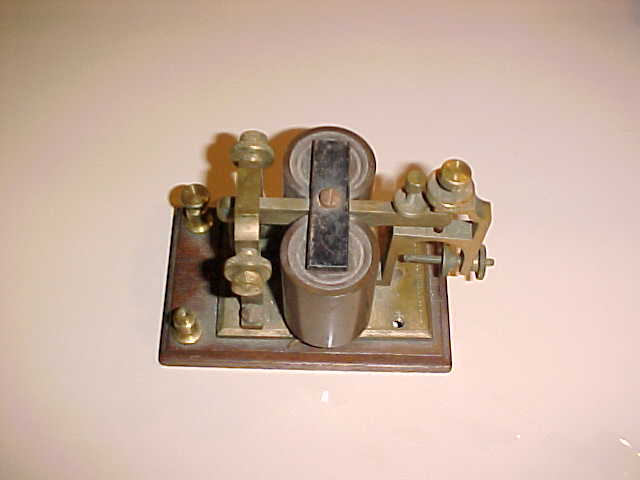
101g Hoggson sounder (top view):(17KB)
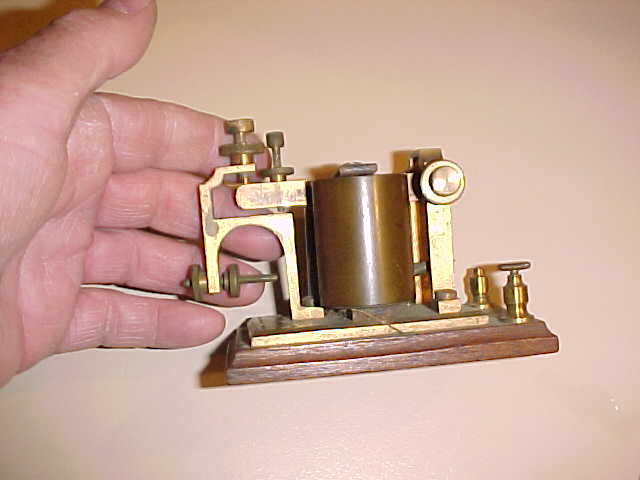
101h Hoggson sounder (side view):(23KB)
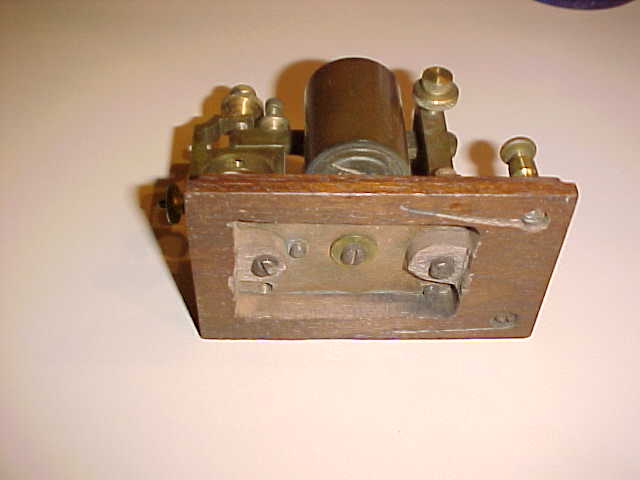
101i Hoggson sounder (bottom view):(19KB)
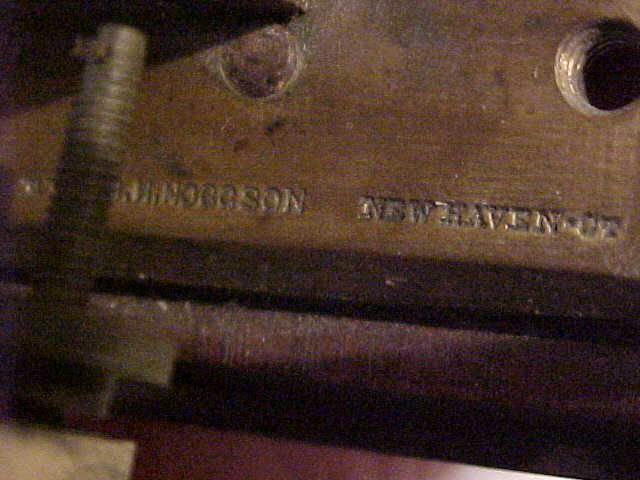
101j Hoggson sounder (maker's label):(35KB)

102 * RARE W. HOCHHAUSEN WEIGHT DRIVEN REGISTER:(25KB)
This magnificent, unusual, and rare round-base Hochhausen register is owned
by collector VE3STN who gave me permission to display it in my museum.
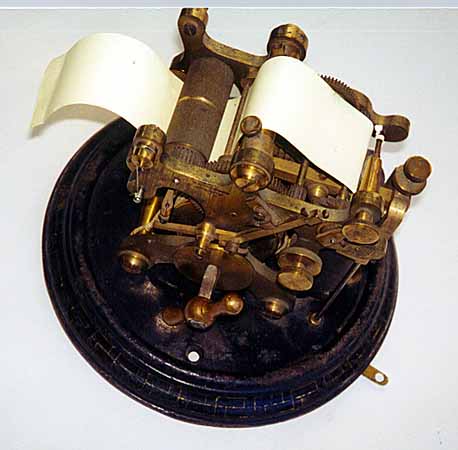
102a * Another view of the HOCHHAUSEN
REGISTER:(31KB)
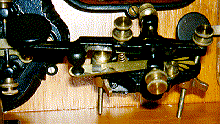
110 PARTRICK & CARTER LEG KEY:(16KB)
Very early step-down cast lever. Black Japanned finish w/gold
trim paint. Shorting switch.Spring adjuster.

111 * PARTRICK & CARTER LEG KEY:(16KB)
Similar to # 110. Very early step-down cast lever.
Black Japanned finish w/gold trim paint.
Shorting switch. Spring adjuster.
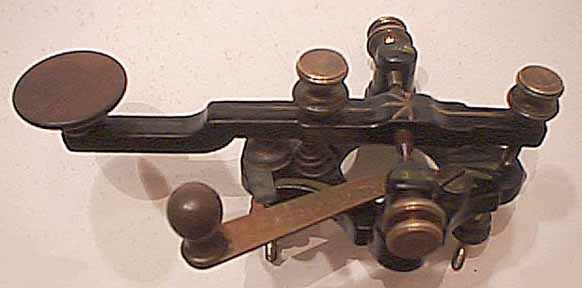
111a Another view of the Partrick & Carter
leg key:(19KB)
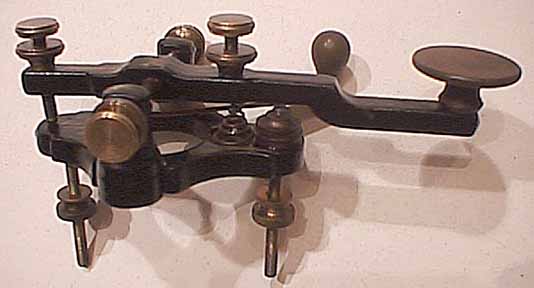
111b Another view of the Partrick & Carter
leg key:(19KB)
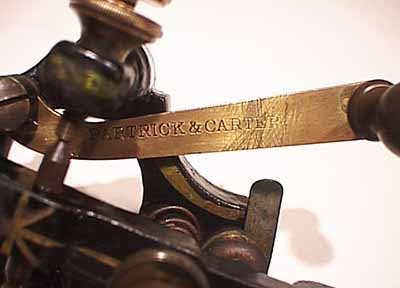
111c Another view of the Partrick & Carter
leg key:(16KB)

120 ** VERY EARLY SWEDISH SORENSEN WEIGHT-DRIVEN
EMBOSSING REGISTER:(60KB)
This is a very early Swedish weight-driven register made by Sorensen in
Stockholm, Sweden. The shape of the frame is very similar to the very
earliest of the German Siemens registers. The picture was provided by
Collector Jan Skoldin, SM5LNE.
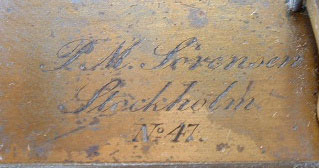
120a ** A closer view of the Sorensen Label:(16KB)

125 VERY EARLY AUSTRIAN EMBOSSING
REGISTER:(25KB)
This is a very early Austrian embossing register. Before dots
and dashes were inscribed on the paper tape in ink, embossing registers
such as this one used a blunt stylus to emboss impressions into
the tape. These long and short impressions were read by eye
and transcribed into letters. The register is signed:
CZEIJA & NISSL, WIEN (Vienna, Austria) Number 769.

130 * EARLY FREDERICK, PEARCE MORSE REGISTER:(12KB)
This lovely and unusual register was made by Frederick, Pearce & Co., of New
York probably in the 1870's. The coils are enclosed within the large,
elaborately decorated 9" x 12" iron base. It uses an ink roller
mechanism to mark the paper tape and has a lever-arm winding mechanism.
Frederick, Pearce of 77 & 79 John Street in New York were successors to
Pearce & Jones of 64-66 John St. who were established in 1872.
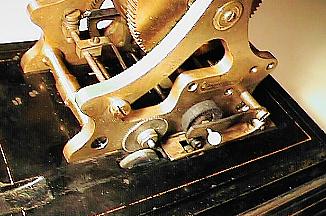
130a A closeup view of the ink-roller mechanism:(26KB)
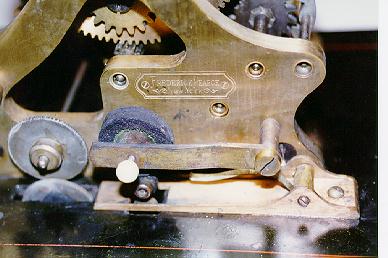
130b A very closeup view of mechanism and label:(35KB)
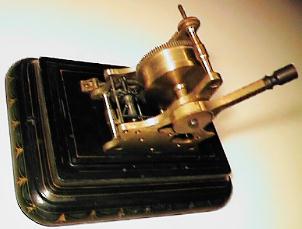
130c A back view showing spring winding lever:(13KB)
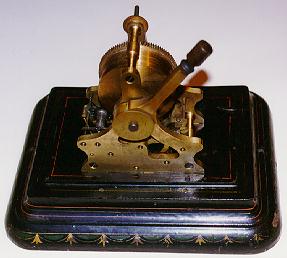
130d Another back view showing spring winding lever:(13KB)
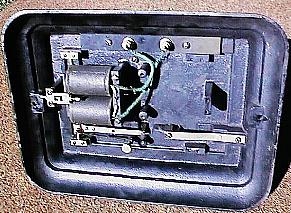
130e View of bottom of base showing the coils:(29KB)
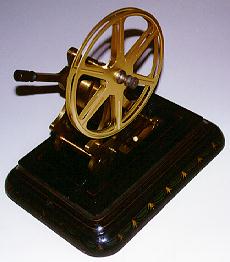
130f Front of register with reproduction supply reel:(19KB)
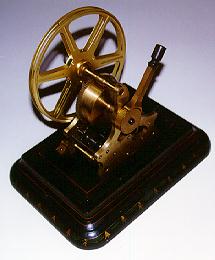
130g Rear of register with reproduction supply
reel:(20KB)
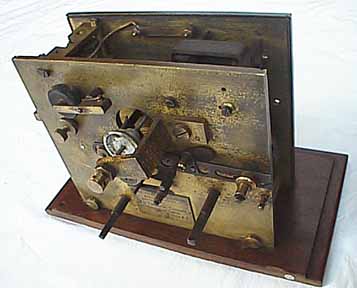
135 EARLY BRITISH STELJES PATENT TYPE-PRINTING TELEGRAPH
REGISTER:(18KB)
This is a very unusual early dual weight-driven type printing telegraph
register. There are two large drums for the cord coming from the
two weights which provide the power to operate the register. It is not
clear how this device functioned but the two solenoid coils apparently
selected the character to be printed on a paper tape by arotating print
wheel.
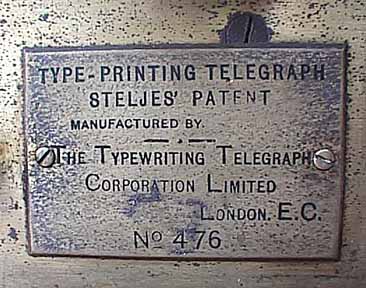
135a A view of the Manufacturer's Label:(35KB)
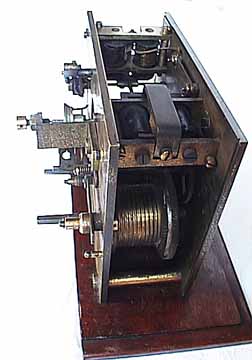
135b A view showing the inner mechanism:(18KB)

140 WATTS CAMELBACK KEY:(30KB)
This interesting camelback key was made by Watts & Co. of Baltimore,
Maryland in the early 1870's. The lever is stamped WATTS & CO.
BALTO MD. The Shorting switch is stamped PAT.AUG 27, 72, and
consists of two strips of brass, lying over each other. Note that
the base is absolutely identical to that of a Phelps camelback.
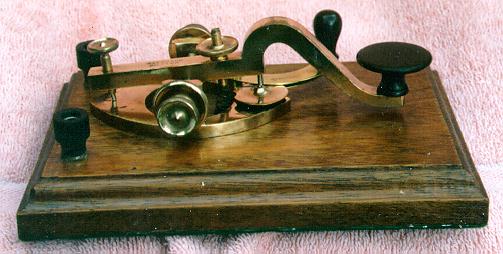
140a The other side view of the Watts
Camelback:(31KB)
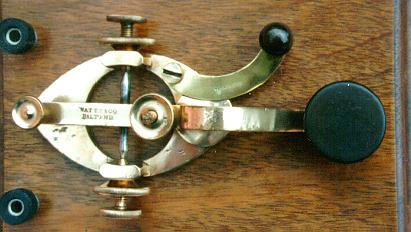
140b Top view of the Watts Camelback:(23KB)
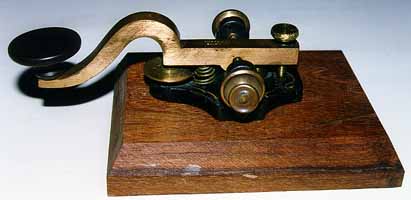
145 WATTS MINIATURE CAMELBACK KEY:(15KB)
This miniature camelback key was made by Watts & Co. of Baltimore, MD
in the 1870's.
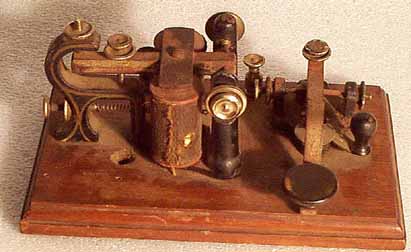
147 * VIADUCT KOB WITH MINIATURE CAMELBACK
KEY:(21KB)
This early KOB has a rather distinctive sounder and a miniature
camelback key which is identical to the Watts Miniature Camelback
Key seen as item 145.(The Derek Cohn WB0TUA Collection)
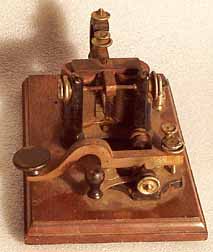
147a A Side view of the Viaduct KOB:(14KB)
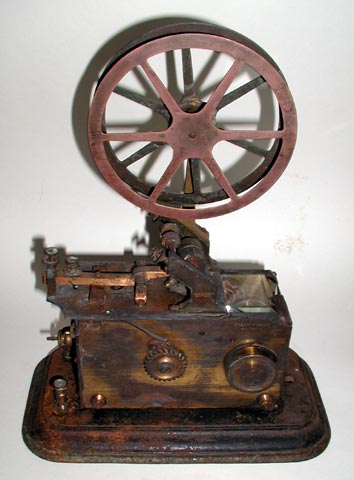
148 * VIADUCT SPRING DRIVEN REGISTER:
This register marked a moving paper tape with the dots and dashes of the Morse
Code. It is labeled: VIADUCT, BOSTON.
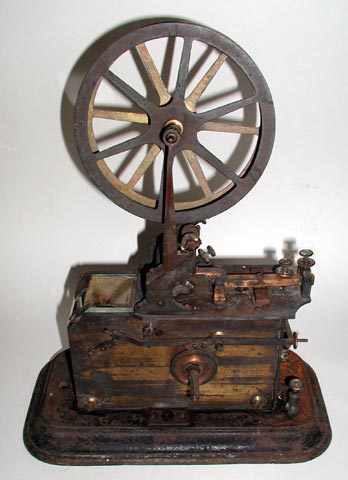
148a * The other side of the Viaduct Register:
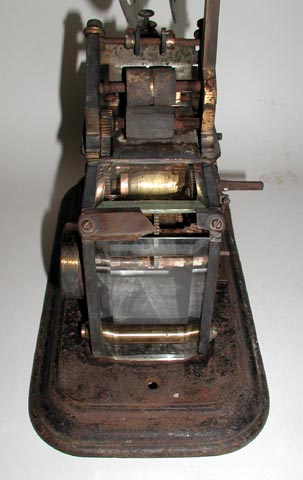
148b * End view of the Viaduct Register:
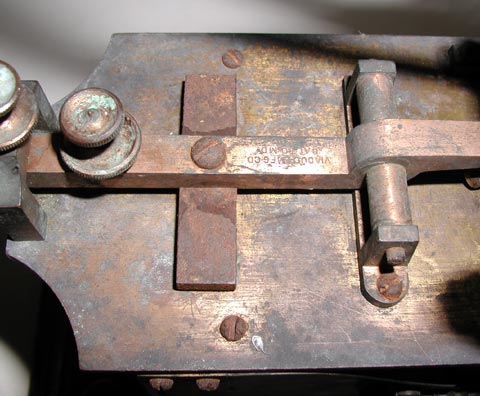
148c * The moving armiture of the Viaduct Register:
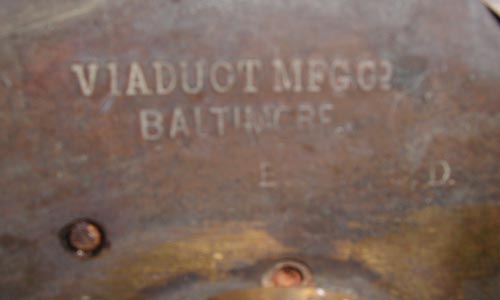
148d * The maker's stamp on the Viaduct Register:
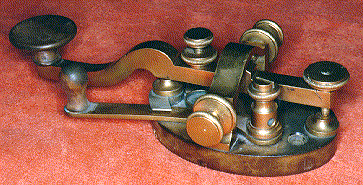
150 EARLY TILLOTSON "ARCHED" CAMELBACK KEY: (40KB)
This Tillotson camelback has an unusual oval hard rubber base. The
brass arch over the trunnion from left to right was probably
designed to stabilize the uprights so they did not work loose in
the base. Label reads: L.G.Tillotson & Co. 8 Dey St., New York.
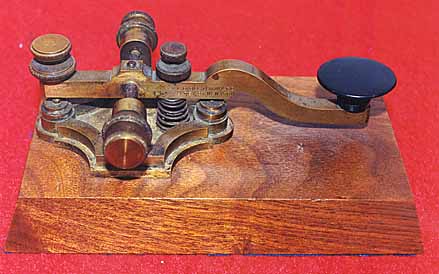
157 * VERY EARLY TILLOTSON CAMELBACK KEY:
(25KB)
This lovely early Tillotson camelback key has a base which is identical to
that on the
Number 56 Caton straight lever
key .. suggesting that there was some connection between Caton and
Tillotson. This great key is owned by Joe Schroeder, W9JUV.
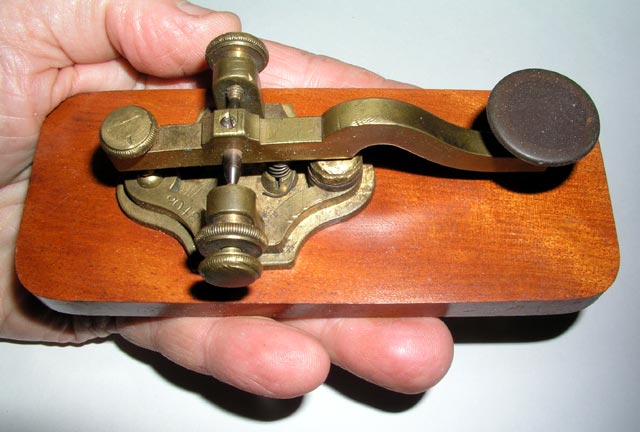
159 MINIATURE TILLOTSON CAMELBACK KEY: (47KB)
Tiny brass-lever camelback key with 3-3/4" lever stamped Tillotson,
6 Dey St.New York, no spring adjusting screw, a lock screw on the steel
trunnion shaft, miniature knob, & brass base stamped 2048.
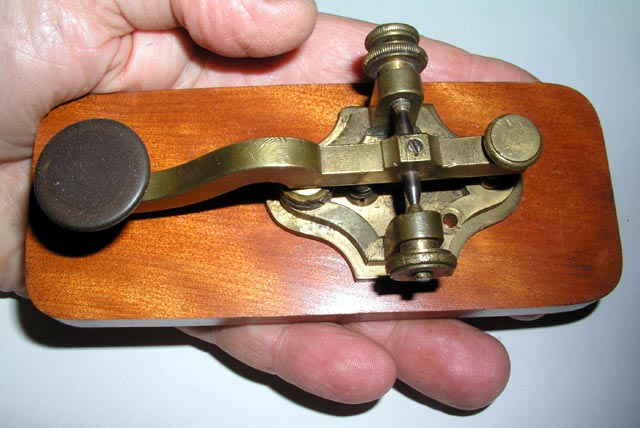
159a Another view of the Miniature Tillotson Cambelback
key: (56KB)
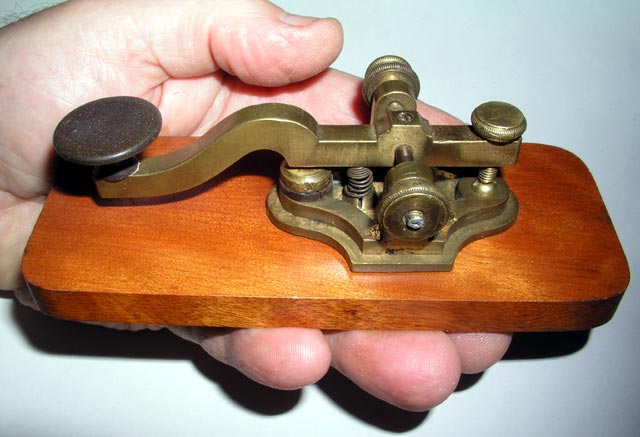
159b Another view of the Miniature Tillotson Cambelback
key: (47KB)
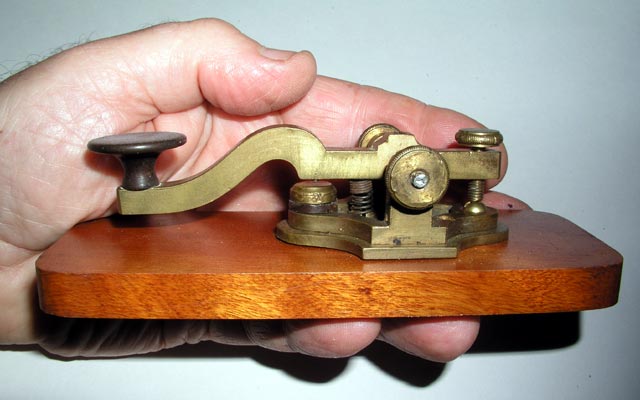
159c Another view of the Miniature Tillotson Cambelback
key: (32KB)
Internet ENIGMA Museum:
https://EnigmaMuseum.com
COPYRIGHT NOTICE: (Copyright (c) 2023: Prof. Tom Perera Ph. D.)
Although all the pictures and text are copyrighted, you may use any of them
for your own personal applications including public lectures and
demonstrations, publications and websites as long as you mention the
w1tp.com Museum. If you plan to offer them for sale to the public
in any form, please email me for permission which I will generally grant as
long as you mention my museum: http://w1tp.com or https://EnigmaMuseum.com My email address is
given at the bottom of this page. Some of the material may require contacting
other copyright owners for commercial use and I will inform you by email.
Please also see the Disclaimer of Warranty.